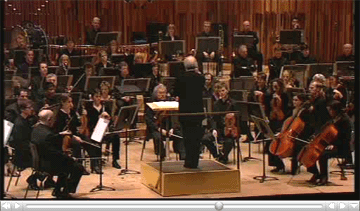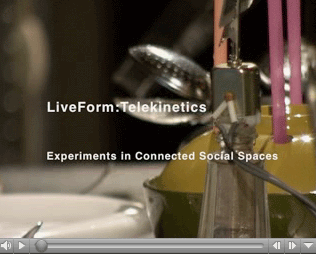« February 2005 | Main | April 2005 »
March 31, 2005
Can You See Me Now in April

Blast Theory performs again their first hybrid reality game
Can You See Me Now?, the hybrid reality game developed by U.K.'s group Blast Theory and Nottingham University's Mixed Reality Lab will be perfomed twice this upcoming month of April in Cambridge, U.K. People from all over the world are able to play online on the virtual streets of Cambridge against Blast Theory's runners on the real city streets. To participate, you need to log-in to the game's website (Can You See Me Now) on April 1-3 from 2-5pm (GMT) or on April 6-8 from 4-7pm (GMT). A more extensive explanation of the game can be found at the same website.
Posted by at 07:39 PM | Comments (0)
SCOOT
![scootFront[1].gif](http://www.turbulence.org/blog/images/scootFront[1].gif)
Tool for Enhancing Relationships Between Specific Groups and New Urban Spaces
SCOOT is a mixed reality experience designed by Deb Polson and Marcos Caceres, to explore the potentials of location-based games. Players have to solve clues located both in the real world and the virtual world. They interact with strange objects, receive information via SMS to their phones and have to text their answers to the games clues back to SCOOT.
As part of their journey around the site players will be introduced to the area and its surrounds. This orientation will not only be spatial, as the game explores also the history of the place and its dynamics. [via near near future]
Posted by jo at 11:08 AM | Comments (0)
March 30, 2005
GPS-Art
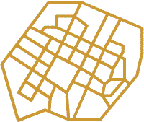
GPS-Trans Net-Cellphone Performances
GPS-Art is a new field of art activity based on motion in open spaces. GPS-Art is the global interactive instrument used for the creation and processing of audio and video material. It integrates elements of audio-visual installation to be used as a new media transmission. The project is based on large outdoor scales of cities and open spaces; it is ready to be realized on land, air, underwater as well as in outer space.
All GPS-Art projects use the GPS-12 device (Global Positioning System), as well as the cell phone system. GPS-12 refers to the 12 satellites hanging above the Northern half of the globe; it's used for navigation and measures in an interactive way many topographic parameters including latitude and speed. These measurments are the starting point of many art projects of GPS-Art. Since 2001 GPS-Art has been realized by a series of GPS-Trans net-cellphone performances.
Posted by jo at 05:13 PM | Comments (0)
Theory of the Dérive

Drifting and Chance
"One of the basic situationist practices is the dérive [literally: "driftingî], a technique of rapid passage through varied ambiances. Dérives involve playful-constructive behavior and awareness of psychogeographical effects, and are thus quite different from the classic notions of journey or stroll.
In a dérive one or more persons during a certain period drop their relations, their work and leisure activities, and all their other usual motives for movement and action, and let themselves be drawn by the attractions of the terrain and the encounters they find there. Chance is a less important factor in this activity than one might think: from a dérive point of view cities have psychogeographical contours, with constant currents, fixed points and vortexes that strongly discourage entry into or exit from certain zones." From Theory of the Dérive by Guy Debord.
Posted by jo at 04:24 PM | Comments (0)
FLOATING POINTS 2: Networked Art in Public Spaces

Tune in TONIGHT!
WHO: Pete Gomes and 38 North 118 West’s Jeff Knowlton + Naomi Spellman; DATE & TIME: March 30, 2005; 7:00 p.m. (EST, US); VENUE: Emerson College, Bill Bordy Theater, 216 Tremont Street, Boston and streamed live.
PETE GOMES' work fuses new technologies and cinema. His "Geocinema" project utilizes Global Positioning Systems (GPS) and other devices to explore what it means to be able to return to the exact location where a film was made and how to utilize this ‘unseen’ information in the film. Gomes is a freelance director and digital film lecturer at the Architectural Association, London. He is also founder and director of "Park Bench TV" and "mutantfilm."
38 NORTH 118 WEST focuses on site specific experimental works utilizing digital media, computing, and internet resources, and explores inventive ways to use GPS technology with rich cultural content. Jeff Knowlton is an artist, musician, lecturer, programmer, and museum preparator. Naomi Spellman is a transmedia artist and educator. Both teach at the University of California, San Diego.
FLOATING POINTS 2 is co-presented by Emerson College and New Radio and Performing Arts, Inc. (NRPA), a New York-based organization that opened an office in Boston in 2002. The series is made possible by Emerson College and the LEF Foundation.
Posted by jo at 08:55 AM | Comments (0)
Visitor.Files

Observer and Observed
"Is it possible to be a stranger in your own neighborhood? The Visitor.Files project--by Christina Ray--originated with a wish to replicate the heightened awareness commonly felt when first landing in a foreign city, when every person, sight and smell appears curious and full of potential. For this project, I attempt to become a temporary visitor even in the most familiar of locations.
Visitor.Files documents the common flow of city sidewalk activity with multiple media and translates the recorded observations into a visual code presented as a series of hand-drawn maps." Continue reading >>
Posted by jo at 08:40 AM | Comments (0)
Networked Multi-sensory Experiences:
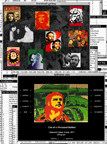
Beyond Browsers on the Web and in the Museum
"Abstract: The defining characteristic of the digital era is the potential that it brings for “real-time” interconnection between anything that can be measured, expressed, or controlled digitally. The World Wide Web stems from one type of digital interconnection: well-defined standards linking a “browser” with remote machines presenting information to be browsed. Yet digital technology enables more than just new approaches to presentation, browsing, and searching. It can create dynamic connections between different physical spaces and across sensory boundaries, and provide experiential interfaces for interaction that move beyond the mouse, keyboard, and screen. It can relate the physical space of the museum to the virtual space of the Web for both individual and group experiences." From Networked Multi-sensory Experiences: Beyond Browsers on the Web and in the Museum by Fabian Wagmister and Jeff Burke.
Posted by jo at 08:30 AM | Comments (0)
Phonic Frequencies:
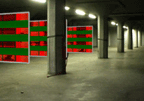
Shaping Networked Realities
ABSTRACT: The paper introduces a networked multi-user installation and interactive mixed reality environment that combines the fields of interactive art, telecommunication and streaming technologies. Phonic Frequencies is an audiovisual data space whose appearance can be altered via networked communication devices. Visitors are active agents and participate in shaping spaces as they control audiovisual data with their telephones.
Linking the physical space to the digital network space, Phonic Frequencies opens a hybrid reality for distributed sound exchange and visual communication, blurring the boundaries between verbal communication and digital information. The work attempts to break the conventional communication cycle of bidirectional dialogue and to consider the meaning of in- and output from a different perspective." From Phonic Frequencies: Shaping Networked Realities by Tamas Szakal, Christoph Groenegress, Wolfgang Strauss, Predrag Peranovic (c) 2003
Posted by jo at 07:40 AM | Comments (0)
Multimodal Telepresence and Teleaction
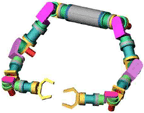
Telepresence, Haptic and Networked-Control Systems
"Telepresence has been defined by Prof. Thomas B. Sheridan in 1992 as a system in which the human operator receives "sufficient information about the teleoperator and the task environment, displayed in a sufficiently natural way, that the operator feels physically present at the remote site". Hence a telepresence system enables a human operator to perceive and manipulate a remote environment.
A telepresence system consists of three components. The human system interface (HSI) is handled by the human operator. He/She commands the teleoperator to perform actions in a remote environment. HSI and teleoperator exchange command and feedback signals over a communication line.
To achieve a holistic remote immersion, multiple modes of human perception are addressed including haptic, visual, and auditory senses. The level of the immersion is called the transparency of the telepresence system. To reach this goal telepresence conglomerates three disciplines: robotics, telecommunications and virtual reality.
Intended applications for telepresence systems are telesurgery, teleassembly and teleservice systems. In hazardous environments, for example, multimodal telepresence will provide significant benefits. As illustrated in the figure below search-and-rescue operations could be done by a tele-commanded robot reducing risks and increasing efficiency." Continue reading >>
Posted by jo at 07:30 AM | Comments (0)
March 29, 2005
DIALTONE

Teleinteractive Net Audio Experiment
DIALTONE is a net audio installation exposing the physical and virtual space of the internet and attempting to open this hybrid space for sounds, noises and words by using simple telecommunication instruments like telephones and answering machines. This audio interface between telephone network and internet explores how interaction and compression changes audio in a network. The installation connects the venue to our telecommunication network through sound and vision.
Posted by jo at 03:01 PM | Comments (0)
The Royal Society of Emotional Geocachers
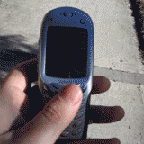
Place is Story>>Character Equals Space
Navigate a hypertext journey of sound, image and video where stories and characters intersect over time and across the city geography as one link leads you on foot to another. Available via GPRS on your mobile phone, or download from the internet on to your PDA (such as a Palm Pilot).
"This site exists for members of the society to document key personal experiences at specific locations. Please join us and add your own story of place. We've designed this site specifically for mobile devices so members may read & comment upon other members experiences in situ. The Rules; be true, place is story, character equals space, every story must connect to another story. Every tale must contain gps co-ordinates, maps and directions."
Posted by jo at 02:30 PM | Comments (0)
Switch Interview with Victoria Vesna
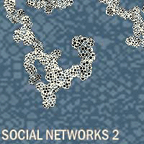
Extending Our Influence Beyond Our Local Spaces
"Inna Razumova: The Web is an ephemeral, virtual medium that is associated with the mobility, manipulability, and transformation of data. Web is also one of this culture's primary places for a fetishization of the body. (spy cams, pornography, dating networks, avatar-based chat rooms, etc.). In your opinion, why is a medium that functions mostly through disembodiment so fascinated with the idea of body?
Victoria Vesna: It is because our bodies do not only consist of embodied, physical parts and our minds are not separate from our bodies and we are not separate identities. I do not consider this an opposition (idea of body/disembodiement), but a return to learning that we have etheric bodies, and can make telepathic connections to others on the other side of the planet. It is very empowering to have a sense of connection to someone who shares your ideas, whatever they may be, and feel a physical sensation in relation to this...The Internet provides a space for exploring our many identities, and experimenting with ideas of extending our influence beyond our local spaces." From Interview with Victoria Vesna by Inna Razumova, May 15 2001, Switch, Issue 16.
Posted by jo at 02:11 PM | Comments (0)
KromoZone
A Platform for Networked Multimedia Performance
"Abstract: Kromozone is a networked, interactive/intra-active, computer-based realtime performance system. All elements are interconnected via ethernet interfaced within the Max/MSP/Nato environment. This allows for information at any station to be passed to any other station for control, monitoring, reinterpretation, and processing. An audio station’s parameters can effect the manipulation of video at another station for example. This creates not only interaction between performers, but intra-action where performers can actually get ‘inside’ each other’s instruments and directly affect the output. In some performances, stations are placed throughout the audience, who is invited to participate. In using the KromoZone performance system, we have explored the implications of networked performance, the use of alternative sources for signal and control input, the design and use of non-standard performance interfaces, and the inclusion of live-manipulated video projections as a viable and integral part of a performance." From KromoZone: A Platform for Networked Multimedia Performance by Stephan Moore and Timothy A. Place, University of Missouri, Kansas City.
Posted by jo at 01:53 PM | Comments (0)
Liquid Gold
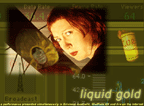
An Artery of Liveness
Liquid Gold--by the Transmute Collective--was a live performance event that spanned the globe, using the Internet to link several sites and audiences into one entire 'net-worked' performance. It consisted of several intensely quirky performances, accurately coordinated across multiple time zones. Liquid Gold demonstrated a new kind of net-work, using the Internet as the artery that spreads a new performance experience of networked 'liveness' across the world.
Liquid Gold brought together filmmakers, artists, musicians, network specialists and writers to make a new work of live art both in real space and throughout the global electro-o-sphere. It employed a custom built chat server ('idea animator'), running in the physical live venues and on all Internet located audience's browsers. This allowed writers in both Australia and England to describe what they saw locally in their own performance venue - putting back some of the 'liveness' lost through the lo-fi images and sounds the web currently allows.
Liquid Gold used its novel approaches to present one woman's journey of reconciliation - a trip that will allow her to reconcile the ghosts of her chequered past and travel towards the new futures that her vivid imagination are now making possible.
Performer Lisa O’ Neill, in the persona of adventurer and strong woman 'Ling Change', was filmed live on video as she traveled throughout the stunning internal landscapes of the Brisbane Powerhouse Centre for the Live Arts, an old industrial site now converted into a major arts complex.
Her journey proceeded from the depths of the 'turbine room' and finished in the dramatically patterned glass of the main atrium.
Video imagery of this journey was streamed live across the Internet to Site Gallery, Sheffield, England. There an assembled audience watched as Keith Armstrong directed the work, mixing the Australian streamed vision with further performance vision and audio, unfolding a bizarre narrative which developed in real time between the live and pre-edited footage.
The two steams of video (From Brisbane, Australia and Sheffield, England) were projected upon adjacent screens in both the physical spaces, with the audiences 'editing' their own performance from these two images.
The work was webcast live for online audiences and incorporated a custom interactive chat facility, called an 'idea animator'.
LIVE WEB CAST: The live webcast showed prerecorded footage of the main character ('Ling Change', performed by Lisa O'Neill) traveling through animated landscapes mixed live with the images from the live performance in Brisbane. This mix was undertaken by the show's artistic director Keith Armstrong in Sheffield. All original sound for the show was composed by Guy Webster.
These dual narratives showed Ling's journeys in some past time, and now in the present, as she moved through strange industrial landscapes. (filmed live in the striking industrial interiors of the Brisbane Powerhouse). Hence audiences were asked to construct the narrative online, as the characters' actions shifted from virtual to actual architectures"
Online viewers with high specification machines and plenty of bandwidth could enjoy the luxury of participating in both the video stream and interactive chat dialogue, whilst also surfing background information. The video stream was kept as minimal as possible to avoid excluding other users on slower computer systems.
IDEA ANIMATOR: The 'liveness' of this work, particularly for the web-based audiences, was enhanced by a idea/animator/custom chat server which allowed two writers, situated both in Brisbane and Sheffield, to comment in real time upon their impressions of the performance as they saw it evolving in their respective venue.
The writers at each physical venue referenced performers, imagery, audience, environment and global communication. Remote viewers, and those present at each venue, watched the writers words appear in real time on their screens alongside the performance imagery. Throughout this poetic dialogue key words/ideas were extracted from each writer's texts and became animated upon a large projection screen.
This idea animator software, designed and constructed by Gavin Sade, allowed keywords and ideas to float onto the screen and animate.
When online users logged in their presence was seen by all those also logged via the Internet along with those audiences present at the two live venues. Online users could participate by selecting words already animating on the screen by clicking upon them... this caused the ideas/words to regroup and grow according to the online audience interactions. [Related]
Posted by jo at 12:17 PM | Comments (0)
March 28, 2005
LAST CALL FOR ENTRIES: Turbulence
![]()
Turbulence Juried International Net Art Competition
New Radio and Performing Arts, Inc. is pleased to announce that with the support of the Andy Warhol Foundation for the Visual Arts, 5 net art projects will be commissioned for the Turbulence web site in a juried international (open to everyone) competition. Each commission will be $5,000 (US).
DEADLINE: March 31, 2005; see GUIDELINES--JURORS: Wayne Ashley (US), Arcangel Constantini (Mexico), Sara Diamond (Canada), Melinda Rackham (Australia), and Helen Thorington (US).
Posted by jo at 05:47 PM | Comments (0)
teletaxi
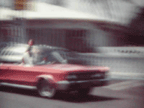
Car #235
Year Zero One is pleased to present teletaxi, a site-specific media art exhibition in a taxicab. The taxi is outfitted with an interactive touch screen that displays video, animation, audio, and information triggered by an onboard GPS (Global Positioning System) receiver which allows the displayed artwork to change depending on where the taxi is in the city. With the combination of the media/gps technology, the mobile environment and the passenger/audience inside the cab. The eleven artists in teletaxi are offered a unique set of possibilities for showing their work - both technically and thematically.
teletaxi will expose interactive media art to a normally passive audience, by presenting works that explore notions of intimacy, mapping, subterranean space, simulated cities, information architecture, data-visualisation, public interventions, surveillance and psychogeography.
Presented by Year Zero One, in Montreal, from March 21 to June, 2005. As part of the DIS/LOCATION: projet d'articulation urbaine programming of DARE-DARE Centre de diffusion d'art multidisciplinaire de Montréal.
Michael Alstad; Mario Côté; Milutin Gubash; David Jhave Johnston; Patric Lacasse; Virginie Laganière; Valérie Lamontagne; Éric Raymond; Doug Scholes
Camille Turner; Myriam Yates.
Opening Friday April first, from 5PM to 9PM, at Square Viger.
Join us at Dare Dare (Square Viger) for a 'fare free' ride in the teletaxi to navigate some of the neighbourhoods and Montreal sites explored by Year Zero One artists and guests.
To reach Taxi Co-op of Montréal, call at (514) 725.9885 and ask for car #235; For more information, contact Dare Dare at (514) 878.1088
[Related]
Posted by jo at 12:54 PM | Comments (0)
Andrine
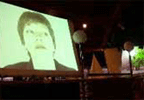
Virtual Personality is Yours to Manipulate
Andrine, developed by The Pooch at Lancaster University (UK), is a virtual personality projected on a screen and reacting to messages sent via SMS. She uses an array of facially expressions to portray her emotions when reacting to the messages.
Each of the 6000 words of her lexicon is partitioned into one of 30 lexicon classifications - including Dislike, Calm, Violent, Angry, Happy and Sad. Each of these classifications are then mapped to the 8 emotions provided by Andrine: Happy, Sad, Angry, Shocked, Laughing, Suggestive, Disgusted, Annoyed. Participants see a huge projection emotively responding to their message. So effective is this response that they are often afraid to insult or anger the avatar. Moreover, Andrine can be "reskinned" to anyone's face in about 5 minutes using a basic webcam. Quicktime Movie. [blogged by Regine on textually.org]
Posted by jo at 11:25 AM | Comments (0)
March 25, 2005
Pervasive Game Development Today
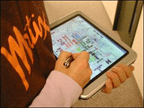
24/7 Immersion
"...Pervasive gaming was first the vision of Swedish company It's Alive!, meaning location-based games that surround you, 24 hours a day, everywhere. When you walk down the street, you're walking through an adventure world draped on top of the real world, and people you meet may be characters in the same game you're playing. Pervasive games are built upon three core technologies: mobile devices, wireless communication, and sensing technologies that capture players’ contexts. It is actually the blend of technologies combined with the location-based and often public nature of game play, gives pervasive games their distinctive identity [Bridging the Physical and Digital in Pervasive Gaming]." From Pervasive Game Development Today by Fabien Girardin.
Posted by jo at 02:10 PM | Comments (0)
The Matrix Online

Actors Hired to Live In-World
"This is amazing news: The Matrix Online is employing 20 'actors' - live humans - to live in-world, interact with players and create storylines.
Since the close of the beta, Warner Bros. Interactive Entertainment announced that it has employed a troupe of 20-odd people whose job it will be to enact narrative scenarios in The Matrix Online live. These people will assume the roles of popular characters, interact with players, and generally move the stories in ways that only live "actors" can. And though it appears that the story hasn't officially commenced, a few players on the Method server were treated to a pretty slick sample of it this afternoon: an extended pep-talk by none other than Morpheus himself." [via Wonderland]
Posted by jo at 02:02 PM | Comments (0)
Eliza Redux

A Robot Who Talks Too Much
Eliza Redux--by Adrianne Wortzel--is an interactive telerobotic web site providing a space for text-to-speech and oral discourse, acting out, and playfulness in the virtual environment of a psychoanalyst's waiting room and inner office. Video and audio of a real physical robot is streamed to the web reactive to visitor text input. Issues of control and lack of control become paramount for the user. Wortzel is implementing ways to bring Weizenbaum's original 1966 ELIZA program into the 21st century.
Wortzel is seeking a computer science professional or student in the New York City area who can lend his/her skills to an internet-broadcast robotic art installation. She is looking for a developer to facilitate communication between clients running flash applications, a server database, and an extremely talkative robot.
Job Requirements:
- SKILLED DEVELOPER in jsp, flash, xml.
- Be able to learn a pre-existing set of commands from the robot control interface.
Ideally, you will also
- Have understanding of database retrieval & modification
- Patiently explain technology needed to execute high-level art ideas
- Be willing to troubleshoot & debug until things work right, everything from web-cams to multiple socket connections.
Job length: Immediate start, completion deadline -end of May.
You will receive at the very least a $500 stipend, and experience/credit in a robotic art installation bound for gallery showing. An article about the project is coming out in the June issue of the prestigious Journal: Leonardo. Plus, you'll get to work in a tech-decked paradise lab with fun people and an even more fun humanoid robot. Even if you don't have all the skills outlined above, we're very interested in hearing from people who are enthusiastic & quick at learning. To apply, contact Prof. Adrianne Wortzel at muse(at)cooper.edu or cell: 646-567-9648
Posted by jo at 01:19 PM | Comments (0)
March 24, 2005
John D. Mitchell + ADaPT
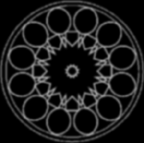
Expanding Sensory and Creative Experiences
John D. Mitchell is a multi-disciplinary composer, educator and researcher committed to using technology for expanding sensory and creative experiences in the arts and education. He has worked with artists from around the world to design and realize projects ranging from multimedia dance archives to interactive multi-site distributed performances.
ADaPT, initiated in December 1999, was the brain child of Mitchell while working under the auspices of the Institute for Studies in the Arts at Arizona State University. ADaPT originally included researchers and information technology specialists from five institutions: Arizona State University, The Ohio State University, The University of California, Irvine, The University of Utah, and The University of Wisconsin, Madison. Over the years ADaPT has expanded to include partners in other countries on four continents.
In 1987, Mitchell and choreographer Gary Lund created Movement Initiated Sound Events (MISE), one of the earliest dance works to use a personal computer and optical sensors for creating a completely interactive, performer driven sound score. Over the next three-years Mitchell and Lund produced several dance-driven, interactive multimedia works for the stage, often collaborating with visual artists and live musicians.
Upon joining Arizona State University in 1990 Mitchell became a founding member of the Institute for Studies in the Arts. At the Institute, Mitchell was instrumental in pioneering the development of the Intelligent Stage – both as a concept and a facility – where he continued to work for the next ten years as a composer, director and interactive media designer. Mitchell has collaborated with numerous artists to create performance works that have been staged throughout United States and abroad.
Mitchell currently directs the graduate emphasis in Dance and Technology and teaches interdisciplinary media and telematics courses in the Department of Dance at Arizona State University. See Using Human Movement to Control Activities in Theatrical Environments by Robb E. Lovell and John D. Mitchell.
Posted by jo at 12:56 PM | Comments (0)
Homebrew WiFi on Sounder Train

DYI WiFi Train
"Sounder commuter rail service from Tacoma is getting a technological boost from its own passengers. SeattleWireless member Casey Halverson is giving a not-so-subtle hint to Sound Transit by offering WiFi in the cars he rides in to and from Seattle every day.
The open wireless node can be found in the first car of the last morning train and in Car 403 on the 5:10pm return trip." [blogged by Dan on Seattlest, via MAKE:BLOG, via feedonfeeds]
Posted by jo at 12:30 PM | Comments (0)
Art Interface Device
![]()
Tool for Responsive Environments
The Art Interface Device (AID) is a microprocessor platform for building electronic installation art. It can also be used as an interface between such artworks and computers. It can enable artworks to respond to people and the physical environment.
The associated AID web site serves as a library of "worked" solutions to common electronic sensing, control and interfacing requirements. From this site the AID user community can download and contribute instructions, parts lists, circuit diagrams and other information relevant to the creation of electronic art. The AID system is distributed under the General Public Licence and developed by the AID user community.
Posted by jo at 12:07 PM | Comments (0)
Blast Theory presents Can You See Me Now?
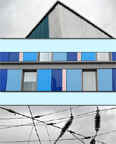
Join the Hunt
Played online and in the streets, BAFTA-nominated Blast Theory challenge you to a game of cat and mouse around a virtual map of Cambridge. Log on using the public terminals situated in the Junction's new café bar or play online at canyouseemenow and be dropped in at a random location from where you must avoid capture by the Blast Theory 'runners'.
Eavesdrop on your pursuers' conversations and swap tactics with other players as Blast Theory (as real actors positioned on the real streets of Cambridge) hunt down your virtual presence with the aid of handheld computers and GPS technology. FREE to play. April 1st-3rd 2-5pm; April 6th-8th April 4-7pm at The Junction, Cambridge.
Artists' Workshop: April 6th 1-4pm; £5/£4 concessions
The player is a key feature in all Blast Theory's work. This afternoon workshop will look at how the audience engages directly with an artwork, in dialogue with other 'players' and the artists.
Using the player as a focus, participants will respond creatively to site/space, game structure and forms of media/communication technologies to inform and stimulate their own media and performance practice. Finally all participants are welcome behind the scenes at 4pm to look at the hardware, software and performance preparation of 'Can You See Me Now?' Blast Theory's award-winning interactive game, presented by the Junction.
Suitable for artists looking to expand their understanding on new performance technologies, participants should come prepared to move, draw and talk.
To book a place call the Junction box office on 01223 511511 or visit in person at The Junction, 2 Clifton Way, Cambridge, CB1 7GX. [via DAN]
Posted by jo at 11:42 AM | Comments (0)
HyPod
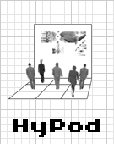
Body as Interface
HyPod is an interactive multimedia installation that invites the public to use their bodies as an interface and, coordinating their movements with other people in the same dark room, navigate a hyperdimensional world of images and sounds created by dozens of artists around the world. HyPod is based on a Web-based project called HyGrid.
HyGrid is a digital art piece currently undergoing collaborative creation by many different artists around the globe in a continued visual dialogue. With HyPod, a group of people gathered in the same physical location can navigate together through HyGrid. Using their bodies as an interface, they can experience how it feels to collaborate and interact with other participants in the process of viewing the work. Beside the images created by Sito Electronic Arts collective, HyPod also features original sound integrated with the interactive installation.
Lenara Verle is an artist and researcher in the field on Net art and collaborative art. Participates since 1994 in the award-winning group Sito Electronic Arts (www.sito.org - receiver of the Prix Ars Electronica in 1996 for the collaborative project HyGrid). Summer 2000 UNESCO-ASCHBERG resident artist at the art and technology research center CAiiA+STAR, England (www.caiia-star.net).
CAPES/APARTES Young Artist Grant laureate 2001 at the New School, New York. Participated in collaborative art exhibits in Rome, Italy; Porto Alegre, Brazil; Montreal, Canada; New York and Los Angeles, USA. [via Rhizome]
Posted by jo at 11:27 AM | Comments (0)
March 23, 2005
Honey, I Geotagged the Kids

How collaborative cartography could enable us...
"...Whether it's wearable computing that tracks our locations no matter what we happen to be doing, cell phones that let us enter our locations, moods or other data, or even all the wireless nodes, satellites and grid networks capable of finding, resolving and comparing all this information, we're talking about an entirely wireless phenomenon. We're also talking about what might prove to the be ultimate legacy of all our hard work here in the wireless trenches: locative media.
The phrase itself was originally coined by Karlis Kalnins, of gpster.net, who applies the precise logic of linguistics to an otherwise seemingly vague field. "Locative is a case, not a place," Kalnins says, meaning it stands for a final location of an action or the time of the action. In other words, it doesn't just happen in space, like a map, but also in time..." From Honey, I Geotagged the Kids by Douglas Rushkoff, theFeature.
Posted by jo at 10:22 AM | Comments (1)
Crosswalk
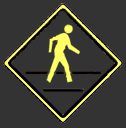
Urban Action
Crosswalk --a Providence Initiative for Psychogeographic Studies (PIPS) publication--is dedicated to further investigations in psychogeography, experimental public art, critical architectural theory, and all practices inbetween. Crosswalk v1.1: Psy-Geo Provflux 2004 was published to coincide with the first annual Psy-Geo Provflux, a two day event investigating how the urban landscape in Providence (Rhode Island, USA) affects its social and artistic community. A call has just been issued for Psy-Geo Provflux 2005.
Crosswalk v1.2::Space Ships includes "Collective Practices," "Interventionist Diaries," "Contemporary Nomadism," "Free Culture," and "Public vs Private."
Posted by jo at 09:57 AM | Comments (0)
Vectors
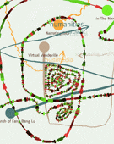
What a Tangled Web
"While viewers of net art are used to layered reading and articles enhanced by visual and interactive components, Vectors, a new online journal published by The USC Annenberg Center for Communication in Los Angeles, is one of the first to introduce complex interactions into academic writing. While each of the eight projects presented in the inaugural issue of Vectors has a unique look and approach to the subject of Evidence, all are linked--graphically and conceptually--through numerous thematic threads. These threads are explored in the 'Vector Space,' an interactive section of the journal where viewers can draw lines on the screen to illuminate where the various contributions intersect. There are numerous ways to enter into, explore, and visualize Vector's and although those who would rather download a text may be disappointed, those enthusiastic about expanding forms and of academic discourse will find Vectors a winding and welcome addition." - Jody Zellen, Net Art News, Rhizome.
Posted by jo at 09:49 AM | Comments (0)
Drift
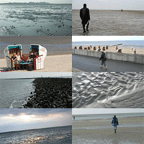
Being Lost
"The ubiquity of GPS (global positioning satellite) and other tracking technologies suggests that "being lost" may itself be an experience that is being lost. However, simply knowing ones geographical location as expressed in longitude and latitude coordinates has little bearing on ones personal sense of place or direction. Drift poses the age-old question "Where am I and where am I going?" in a contemporary moment in which spatial positioning and tracking technologies provide evermore precise, yet limited, answers to this question.
The installation embraces the flow of wandering, the pleasure of disorientation, and the playful unpredictability of drifting as it relates to movement and translation. Sounds blend footsteps on different surfaces with spoken word in different languages. Spoken word passages are drawn from poetry and literature dealing with the theme of wandering, being lost, and drifting. Meaning also drifts as Rousseau, Joyce, Kerouac, Mann, Dante, Woolf, and others are presented in the original and in translation. The Watten Sea becomes a metaphor for hertzian space as visitors are invited to wander among layered currents of sand, sea and interactive sounds that drift with the tides, and with the shifting of satellites as rise and set, introducing another kind of drift.
The installation covers a 2 km x 2 km region that is filled with areas of interactive sound. The region moves with the tide such that at low tide all the sounds are out on the Watt, at high tide they flood the town. Sounds play automatically as you wander through these interactive areas with a Pocket PC, GPS and headphones. The location of the areas changes constantly with the shifting tides - therefore, the best strategy for finding them is simply to wander."
Posted by jo at 09:47 AM | Comments (0)
March 22, 2005
eBay: VIDEO outsider art burka guido-catherine
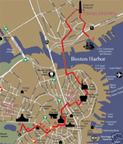
Burka on Freedom Trail
Subject: Burka on Freedom Trail
"You are bidding for me to walk the Freedom Trail in Boston wearing a burka and bunny ears. Winner will receive a video and 3 photographs documenting this event."
Current bid: US $0.99; Time left: 4 days 17 hours
[Related]
Posted by jo at 06:05 PM | Comments (0)
John Cage's 4'33" Revisited
CLICK ON IMAGE TO PLAY MOVIE [Format: MP4 38.5mb]
BBC 4, 2004 (9:22), January 15, 2004. [via UbuWeb]
Radio 3 plays 'silent symphony'
BBC Radio 3 has aired more than four minutes of complete silence... by design. The BBC Symphony Orchestra gave a performance of composer John Cage's seminal piece 4'33", which does not contain a single note. Radio 3 broadcast the entire composition live, even having to switch off its emergency system that cuts in when there is apparent silence.
The performance took place on Friday night at London's Barbican Centre. It was part of a weekend of Cage's work. The late avant-garde composer "wrote" the piece in 1952. TV viewers were also able to watch the event when BBC Four broadcast the concert, which also featured works that music lovers could hear.
Cage's reasoning for composing 4'33" was to demonstrate that "wherever we are what we hear mostly is noise". Mostly what you could hear was people getting up and walking out. BBC Symphony Orchestra general manager Paul Hughes of the 1952 premiere. His estate won a bizarre copyright battle in 2002, when composer Mike Batt agreed to pay a six-figure sum to a charity because his album featured a tongue-in-cheek silent track which he credited as co-written by Cage.
General manager Paul Hughes told BBC Radio 5 Live the orchestra had rehearsed to "get in the right frame of mind". Despite having no notes to play, the musicians tuned up and then turned pages of the score after each of the three "movements" specified by the composer. The silence was broken at times by coughing and rustling sounds from the audience, who marked the end of the performance with enthusiastic applause.
Mr Hughes denied the performance was a "mindless gimmick" and said Cage believed "music was all around us all the time" and the piece was his attempt to make the audience focus on sounds that were "part of our everyday lives".
'Discomforted'
But the audience at the premiere in 1952 was "so discomforted that mostly what you could hear was people getting up and walking out", he said. "They were completely outraged and extremely angry," Mr Hughes added. He said Cage, who died in 1992 aged 80, was very proud of the silent composition. In readiness for the performance, Radio 3 bosses switched off their emergency back-up system - designed to cut in when there is an unexpected silence on air.
Posted by jo at 03:49 PM | Comments (0)
UBUWEB
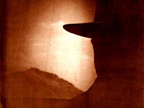
37 Short Fluxus Films
UbuWeb is pleased to present 37 Short Fluxus Films. Dating from the sixties and compiled by George Maciunas (1931-1978, founder of Fluxus), this is a document consisting of 37 short films ranging from 10 seconds to 10 minutes in length. These films (some of which were meant to be screened as continuous loops) were shown as part of the events and happenings of the New York avant-garde.
Starting in the early sixties, Fluxus followed in the footsteps of the Futurist and Dada avant-gardes, going against the established grain of Fine Art and Official Art and promoting imposture as an aesthetic dimension. Fluxus interdisciplinary aesthetic brings together influences as diverse as Zen, science, and daily life and puts them to poetic use. Initially received as little more than an international network of pranksters, the playful artists of Fluxus were, and remain, a network of radical visionaries who sought to reconcile art with life.
Films by Nam June Paik, Dick Higgins, George Maciunas, Chieko Shiomi, John Cavanaugh, James Riddle, Yoko Ono, George Brecht, Robert Watts, Pieter Vanderbiek, Joe Jones, Eric Anderson, Jeff Perkins, Wolf Vostell, Albert Fine, George Landow, Paul Sharits, John Cale, Peter Kennedy, Mike Parr, Ben Vautier. (16 mm, b&w/color, 120 minutes, 1962 - 1970).
Posted by jo at 10:29 AM | Comments (0)
URBAN SCREENS 2005

Discovering the Potential of Outdoor Screens for Urban Society
URBAN SCREENS 2005 is an international conference ranging from critical theory to project experiences by researchers and practitioners in the field of Art, Architecture, Urban Studies and Digital Culture. The focus is on understanding how the growing infrastructure of large digital displays influences the visual sphere of our public spaces. How can the commercial use of these screens be broadened and culturally curated to contribute to a lively urban society?
The conference will feature three main topics: 1) Shaping the urban media-scapes; 2) Addressing the social value and civic culture; and 3) Experiences from practical case studies. SUMISSION DEADLINE: 1 May 2005
Public space has always been a place for human interaction, a unique arena for exchange of rituals and communication in a constant process of renewal, challenging the development of society. Its architectural dimension, being a storytelling medium itself, has played a changing role of importance in providing a stage for this interaction. The way the space is inhabited can be read as a participatory process of its audience. The (vanishing) role as space for social and symbolic discourse has been often discussed in urban sociology. Modernization, the growing independence from place and time and the individualization seem to destroy the city rhythm and its social systems. New virtual spaces have been populated instead. Starting with the development of virtual cities within chat rooms and spaces for production of identity, we now face community experiments like collaborative wikis, blogs or mobile phone networks in the growing field of social computing. Parallel to this development an "event culture" has evolved in the real urban space of internationally competing cities, focusing on tourism and consumption. In the context of this rapidly evolving commercial information sphere, developers are bringing new digital display technology into the urban landscape.
Considering the social sustainability of our cities it is necessary to look closer at the liveability and openness of public spaces. The experience, made in the new digital communication spheres, might serve as an inspiration for the social enhancement of our urban surroundings. Instead of just showing commercials, could the large outdoor displays function as experimental "visualization zone" of the fusing of the virtual public spaces and our real world? Can screens function as a new mirror reflecting the public sphere, a medium of communication of the city with itself?
The conference wants to launch a discussion about how digital culture can make use of the existing and future screening infrastructure, in terms of art and social or political practices, generating a higher value for its operators and "users". We want to address the existing commercial predetermination and explore the nuance between art, interventions and entertainment to stimulate a lively culture. Other key issues are: mediated interaction, content, participation of the local community, restrictions due to technical limits, and the incorporation of the screens in the architecture of our urban landscape. We are happy to announce our special guest speakers Lev Manovich, Visual Arts Department, University of California, San Diego and Mike Gibbons, Chief Project Manager, Live Events, BBC.
CONFERENCE:
TIME: Friday, 23 Sept. 2005 (extended to 24th according to feedback)
LOCATION: Amsterdam, the Netherlands
ORGANIZATION:
- Geert Lovink, Sabine Niederer, Institute of Network Cultures, Interactive Media, Hoogeschool van Amsterdam
- Jeroen Boomgaard, Department of Art and Public Space, Gerrit Rietveld Academy / University of Amsterdam
- Mirjam Struppek, Urban//ReseARTch, Berlin
CALL FOR PAPERS AND PROJECT PRESENTATIONS
SUMISSION DEADLINE: 1 May 2005
Researchers and practitioners in the field of Art, Architecture, Urban Studies and Digital Culture are invited to submit proposals for papers and presentations on key issues and implemented cutting-edge projects.
The following aspects might serve as guideline for content, addressed in submissions:
Topic 1 "Shaping the urban media-scapes"
- The historical overview of the development an urban media-sphere.
- Future technologies and visions shaping the media-scape
- Critical review of visual and sonic noise versus liveability
- Peoples predetermined media perception in public space
- Melting layers of technology and the cityscape creating a new dimension
- Investigating the aesthetics of design in the context of the urban landscape
Topic 2 "Addressing the social value and civic culture"
- From consumer entertainment to participation of a wide range users
- Limits and challenges of new responsible public-private partnerships
- Mediated interactions as new forms of civic culture and use of public space
- Issues of censorship in content management
- Possible social applications for the community addressing local events, social integration, education
- Long-term value of local identity and cultural diversity through open access?
- Urban branding changing the perception of locations
Topic 3 "Experiences from practical case studies"
- Experiences with production of new and old cultural content for screens
- Technological limits and challenges in content creation and enhancement
- Evaluation studies, responses from participants and interactions
- Case studies of cultural screenings
- The role of government involvement, policy, planning and management
- Experiences with public and private cooperation
- Cooperation with other art forms and creative industries
______________________________________________________________
APPLICATION FORMAT
1. Name of the project/paper
2. Author(s)
3. Contact person (e-mail/phone/fax/postal address)
4. Short 350-word abstract of the paper/presentation
5. Short biography of the author(s)
6. Related web-links
7. Description of the type of media needed for the presentation
______________________________________________________________
ADDITIONAL CALL FOR SUBMISSION OF DIGITAL IMAGES
For a visual screening we are collecting various pictures of urban screens. Please submit high-resolution images in digitalized format, together with the date, the name of the location and photographer.
For your inspiration look at the Russian Internet Journal about large
electronic LED screens: http://www.screens.ru/
______________________________________________________________
FURTHER INFORMATION - MAILINGLIST
Preparations of the event will include an online discussion via a special mailinglist. During and after the conference live web-casting and other online documentations will present the content to a wider audience.
To subscribe and participate in the urbanscreens-l mailinglist register at:
http://listcultures.org/mailman/listinfo/urbanscreens-l_listcultures.org
If you would like to know more, have a look at the background text:
http://culturebase.org/home/struppek/Homepage/urbanscreens_background.html
_____________________________________________________________
CONTACT FOR SUBMISSIONS:
Mirjam Struppek
urbanscreens (at) networkcultures.org
Institute of Network Cultures
t: +31 (0)20 5951866
f: +31 (0)20 5951840
www.networkcultures.org
Posted by jo at 09:14 AM | Comments (0)
LF:TK Experiments in Telematic Dancing
[CLICK ON IMAGE: You'll need Quicktime to view this movie] Experiments in Connected Social Spaces - LF:TK - Kinetic Live Art through the Internet.
Posted by jo at 07:38 AM | Comments (0)
March 21, 2005
2 by Mark Argo
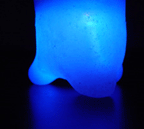
Feeling Connected
hugms is a device designed for sending someone you care about a hug using your mobile phone. Once hugms is connected to your mobile phone all you have to do is send it the phone number of the person you'd like to hug and then squeeze. sensors inside the device read how long and how hard you have squeezed and will format a text message based on your hug.
hugms is a mobject project by Mark Argo. He is developing several devices that will treat the mobile phone purely as a modem/radio, something that gets us connected.
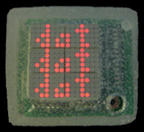
.dot.dot.dot is a wearable display that connects to your mobile phone and is triggered by your communication.
By designing different animations for your closest relationships (best friends, parents, boy/girlfriends) and saving them on .dot.dot.dot you can express to the people around you who you're talking to. if it's your girlfriend, design an animation for a beating heart. when she calls or texts you, .dot.dot.dot will light up with your animation. [via pasta and vinegar]
Posted by jo at 10:51 AM | Comments (0)
SNIF
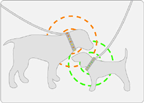
Social Networking in Fur
SNIF, or Social Networking in Fur, is a project from John Maeda's Physical Language Workshop at the MIT Media Lab. The idea is built on the age old notion of petworking-- meeting people through your pets. In their own words: "SNIF presents a hardware/software architecture that aims to capture pet social networks and other pet-related information as pets and their owners explore their communities." Read paper [PDF]; watch movie [Quicktime] [via Josh Rubin: Cool Hunting]
Posted by jo at 10:38 AM | Comments (0)
W.icked W.orld W.ithin

Mixed Realities
Participation lies at the heart of this extraordinary work, offering spectators a rare chance to watch in close proximity to the dancers. Every show is unique and the on-stage audience gets the chance to influence how the piece evolves using special interactive touch pads in the floor.
Inspired by one of the most complex systems supporting human life – the immune system - W.icked W.orld W.ithin, by Ijad Dance Company, is a captivating new dance installation that celebrates and questions the body’s internal logic in its reaction to affliction. Investigating the role of consciousness and memory in the body’s will to survive; what it chooses to accept; what it fights to reject, w.icked w.orld w.ithin [www] is insightful and revelatory.
w.icked w.orld w.ithin is a synthesis of movement and image brought about through collaboration between the fields of choreography, design, digital technology, bio-science, microscopy and projection.
Presented within a specially conceived, adaptable hemispherical set that houses a dynamic visual environment and performed by a company of seven dancers, the production allows technology and artists to interact. This interactive sphere, where body motion, responsive technology and science recreate the fascinating inner world of the human body, promises audiences an evening of rich, sensory experiences; of movement that is both vital and joyous and sensation that is both virtual and real.
IJAD: Contemporary dance with media technology. Founded in 1995 by Joumana Mourad, IJAD Dance Company develops innovative and dynamic concepts within dance, moving with the times and developing work where there are no limits between dance, space, film and technology. The results are highly defined signature performances, the originality of which challenges audiences’ expectations of dance presentation.
Joumana holds a Diploma in Dance Studies from the Laban Centre for Movement and Dance and an MA in Dance and Choreography from Middlesex University. To date, Joumana has created 6 productions for IJAD as well as choreographing for Jumeira Productions, Piedo Dance Company USA, Polite Company, the National Youth Music Theatre Company and US advertising agency Big Photographic.
Joumana has taught contemporary, jazz and creative movement classes at Lewisham College, Living Well Health Clubs and various schools and community centres throughout London. She is also a filmmaker who has created two short films, A Point of No Return and most recently, A Blind Eye Turned, which was filmed entirely underwater in the Lebanon. A Blind Eye Turned, which forms part of IJAD’s production Pas de CinQ, was screened as part of Dance on Screen Festival at The Place Theatre, London in November 1999. She is currently engaged in leading a Dance Advance dance and technology workshop at essexdance on 27th March 2004.
Posted by jo at 09:56 AM | Comments (0)
dyne:bolic
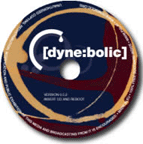
RASTA Software
dyne:bolic is shaped on the needs of media activists, artists and creatives as a practical tool for multimedia production: you can manipulate and broadcast both sound and video with tools to record, edit, encode and stream, having automatically recognized most device and peripherals: audio, video, TV, network cards, firewire, usb and more; all using only free software!
You can employ this operating system without the need to install anything, and if you want to run it from harddisk you just need to copy a directory: the easiest installation ever seen!...dyne:bolic is RASTA software released free under the GNU General Public License. This software is about Digital Resistance in a babylon world which tries to control and market the way we communicate, we share our interests and knowledge. Read the manual here.
Posted by jo at 08:18 AM | Comments (0)
Where The Action Is:

The Foundations of Embodied Interaction
"Where the Action Is--by Paul Dourish--draws on recent research trends in interactive systems to explore the foundations of a new model of using and experiencing computer systems -- what I call "embodied interaction."
The idea of Embodied Interaction reflects a number of recent trends that have emerged in the area of Human-Computer Interaction. For instance, "tangible computing" (as conducted, for example, by Hiroshi Ishii and colleagues at the MIT Media Lab), is an area of HCI research where people are exploring how we can move the interface "off the screen" and into the real world. In this model, we can interact with physical objects which have become augmented with computational abilities. This lets designers offer new sorts of metaphors, or take advantage of our physical skills (like being able to use two hands, or to rearrange space to suit our needs), or even to directly observe and respond to our physical activities in the world (perhaps by knowing where we are and who we're with, and responding appropriately).
A second trend is what I call "social computing," which is the attempt to incorporate sociological understandings into interface design. This approach to HCI design recognises that the systems we use are embedded in systems of social meaning, fluid and negotiated between us and the other people around us. By incorporating understandings of how social practice emerges, we can build systems that fit more easily into the ways in which we work.
These two areas of research -- tangible and social computing -- have been conducted largely as independent research programs. However, I believe that they have a common foundation, and that that foundation is the notion of "embodiment." By embodiment, I don't mean simply physical reality, but rather, the way that physical and social phenomena unfold in real time and real space as a part of the world in which we are situated, right alongside and around us.
The reason that the idea of embodiment is an important one is that it isn't new. In fact, "embodiment" is at the centre of phenomenology, an important strain of philosophical thought beginning at the end of the nineteenth century. Phenomenology rejects the Cartesian separation between mind and body on which most traditional philosophical approaches are based. The idea of disembodied rationality, phenomenologists argue, arises because we think about cognition only in those immediately apparent problem cases where some problem appears in the world that needs to be solved. This ignores 99% of our daily lives, the mundane everyday existence in which we simply go our about business. In place of the Cartesian model, phenomenology explores our experiences as embodied actors interacting in the world, participating in it and acting through it, in the absorbed and unreflective manner of normal experience.
Since the phenomenological tradition has taken the idea of embodiment as a central one, it seems like a good place to turn for help in developing an understanding of the role that embodiment can play in interactive systems. Drawing from the writings of a number of phenomenologists, and especially from Heidegger, Schutz and Wittgenstein, Where the Action Is develops an understanding of embodied interaction organised in terms of the creation, manipulation and communication of meaning, and the establishment and maintenance of practice. Rather than embedding fixed notions of meaning within technologies, embodied interaction is based on the understanding that users create and communicate meaning through their interaction with the system (and with each other, through the system).
On the basis of this understanding, we can set out a range of design principles that are reflected by systems exploiting embodied interaction. This principles not only reflect important issues for design practice, but they also provide a framework for analysing embodied interaction in existing systems."
Posted by jo at 07:57 AM | Comments (0)
THREE CITIES
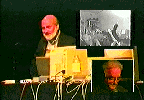
MULTIMEDIA TELE-CONCERT
Featuring Morton Subotnick, David Rosenboom, Steina Vasulka with Leo Smith and J.B. Floyd. The three part evening began with a performance by Morton Subotnick, in New York, who played the Yamaha Disklavier in Santa Monica using finger controlled midi triggers. The second part of the evening was a bi-coastal tele-collaborative concert between David Rosenboom, Dean of the CalArts School of Music in Santa Monica, and pianist B. Floyd and trumpet player Leo Smith in New York City. In each city there were two Disklavier pianos, the one played by the local artist, the second one playing the notes activated by the pianist in the other city. The third part of the evening featured Seina Vasulka in Santa Fe playing a MIDI violin which controller laser videodisk players in both New York and Santa Monica.
As she played her violin in Santa Fe she controlled and selected sections of the videodisk showing her playing the same piece 20 years earlier. Also during the course of the evening we took the Santa Monica and New York audiences through a tour of Netscape-based World Wide Web sites on the Internet and discussed the implications of performing artists disseminating their work and working together through this medium. This is an example of many years of collaboration between ECI, Mort Subotnik, David Rosenboom, Mark Coniligo, and CalArts. This collaboration continues with the hope of showcasing at least one "State-Of-The-Art Tele-collaborative Music Performance a year working with the leading avant-garde musicians of our time. See additional Electronic Cafe projects from 1984-1998 here.
Posted by jo at 07:37 AM | Comments (0)
March 20, 2005
Passion Film: The Message
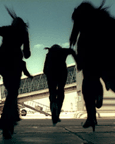
How Your Creativity Sells Airline Tickets
"SN Brussels Airlines has launched a viral campaign that effectively combines movie, web and interaction. The campaign, which is called Passion Film, allows you to integrate your own personal text message into a movie ad and thus, to twist its plot.
In the ad, you see SN airline service personnel receive an important phone call from one of its passengers (the call is from the you). Unfortunately, the passenger has already boarded and the plane is on the runway about to take off. However, with a bit of imagination and bird-like group organization, the friendly personnel manages to get your message through to crew and passengers." [blogged on Guerilla-Innovation]
Posted by jo at 03:06 PM | Comments (0)
Translator II: Grower
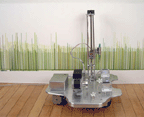
A Cross-Metabolic Relationship
Translator II: Grower, by Sabrina Raaf, is a small 'rover' vehicle which navigates around the periphery of a room. It hugs the room’s walls and responds to the carbon dioxide levels in the air by actually drawing varying heights of 'grass' on the walls in green ink. The Grower robot senses the carbon dioxide (CO2) level in the air via a small digital CO2 sensor. This sensor is mounted high on a wall of the exhibition space and sends data wirelessly to the robot. [via worldchanging]
The number of people in an exhibit space breathing in oxygen and exhaling CO2 has an immediate effect on the sensor. My robot takes a reading of the CO2 level every few seconds and in response it draws a vertical line in green ink on the wall. The line height pertains directly to the level of CO2 (and therefore also the people traffic) in the space. The more CO2, the higher the line is drawn - the maximum height being 1ft. Once Grower completes a line, it moves forward several millimeters and repeats the process. By the end of an exhibition, the bases of all the walls in the space are covered with fine green lines which together resemble a cross-section of a field of grass.
The metaphoric relation is that grass needs CO2 in nature to grow. Here, my simulated grass needs the breath of human visitors in order to thrive. The height of the 'grass' directly reflects on the human activity or traffic in the space. The more people that visit that space, the more amenable that space is to my machine’s ability to create. The relationship between Translator II: Grower, the space, and the public becomes a cross-metabolic one. This piece makes visible how art institutions depend on their visitors to make them 'healthy' spaces for new art to evolve and flourish within.
My machine’s grass growing is a dynamic, emergent behavior in which humans participate involuntarily. This behavior allows the Grower to ‘nest’ the space – meaning, make the space into one where you find evidence of natural, organic change. The drawings of grass may not be organic in a strict sense, but they may be read cognitively the way we read plants or gardens outside. Is the grass thriving? Has there been much activity? Watching the artistic output of a machine that is so sensitive to its environment makes the people in the space more sensitive their environment and its conditions. The grower also provides a memory, through it’s drawings, of those conditions.
My research as an artist focuses on making explicit the interdependent relationships of human to machine as vital entity to vital entity. Grower offers a model where both machines and humans effect each other by their involuntary cooperation. It is a model where human and machine behavior interact in a mutually informative and dynamic manner. [Related]
Posted by jo at 02:28 PM | Comments (0)
March 18, 2005
Postdigital Remix Culture and Online Performance
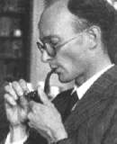
The Ends of Performance
"Peggy Phelan writes on the intersection between knowledge and the medium of the Internet in her introduction to The Ends of Performance [Phelan and Lane, eds. 1997]. Reading and thinking about some of her ideas there started me on a trajectory of thought about performance in cyberspace which has culminated in this website.
The electronic paradigm as an epistemic event represents something more than a new way to transmit information; it redefines knowledge itself into that which can be sent and transmitted… Performance studies, precisely because it has struggled so rigorously with the perils of preservation and the treacheries of transmission, is alert to the Net's potential to flatten and screen that which we might want most to remember, to love, to learn [Phelan and Lane, eds. 1997, p. 8].
On the surface, Phelan's point here seems valid -- many important performative dimensions of human communication are lost in network transmission. Eye contact and body language, for example, are not readable through email, and listening to a webcast is clearly not the same experience as being at a live concert." Continue reading >> [from Postdigital Remix Culture and Online Performance by John von Seggern]
Posted by jo at 05:56 PM | Comments (0)
Weirview
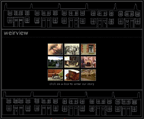
Awakening Community Awareness
"Abstract: This paper presents our experiences with Weird View, a multi-branching interactive narrative, harnessing the power of hyperlinked structures and oral storytelling. True stories were collected by word of mouth from inhabitants of a terrace of houses in Dublin, Ireland, and supplemented with video and photography to form a collection of narrative fragments. A computer application was built to allow the narratives to be navigated. In this way, Weird View attempts to capture part of the community folklore and re-present it to the community in the form of an interactive, nonlinear narrative. The viewer is presented with the fact that a community exists and is continually formed, around place, time, life conditions and social networks. When shown to the community, the Weird View project resulted in awakening community awareness through reappropriation of local, social and personal stories." From Weird View: Interactive Multilinear Narratives and Real-Life Community Stories by Valentina Nisi and Mads Haahr.
Posted by jo at 05:46 PM | Comments (0)
This Text Has Legs
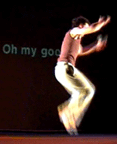
SMS >> Physical Poetry
Theatre etiquette states that mobile phones should be turned off before a show begins, but this new production by C!RCA embraces the intrusive technology. Blending physical theatre, acrobatics and circus tricks, This Text Has Legs is the local circus troupe's most interactive show to date.
Described as a circus show for the communications age, This Text Has Legs has audience members send SMS messages to a large, on stage projection screen. Relying on their improvisation skills, the C!RCA troupe then turn the messages into physical poetry. Guest experimental musicians Lawrence English and Zane Trow weave live sound into the performance and add to the information exchange between audience and performers.
Audiences who are sceptical about a show which relies on live texting should think again. This Text Has Legs premiered last year as part of C!RCA experimental One Night Stands series and it evolved into a full season thanks to the audience's overwhelming response.
Formerly known as Rock'n'Roll Circus, C!RCA is Brisbane's leading post-modern circus troupe. This Text Has Legs is C!RCA first show for its 2005 season, which will feature the troupe's usual modern take on traditional circus skills as well as performances that embrace improvisation, multimedia and experimentation. [PLAY MOVIE [2.3MB] Windows Media] [via creativity/machine]
Posted by jo at 03:34 PM | Comments (0)
I Am Making Art Too

Jill Miller's Performance Art Video Mashup
"San Francisco media artist Jill Miller inserted herself into a seminal 1971 performance art video by John Baldessari. The original piece, itself an ironic commentary on body art, is called "I Am Making Art." Miller's update is dubbed "I Am Making Art Too." As Baldessari moves through his meditative tai chi-esque motions, Miller busts a move to the Missy Elliott soundtrack she added to the clip. According to Miller, the piece raises questions about women's roles in art history and, of course, the power of appropriation and cut-up. See article in the New Zealand Herald. [blogged by David Pescovitz on boingboing]
Posted by jo at 10:07 AM | Comments (0)
March 17, 2005
RedTacton

Skin Transmission
RedTacton is a new Human Area Networking technology that uses the surface of the human body as a safe, high speed network transmission path. It uses the minute electric field emitted on the surface of the human body. Technically, it is completely distinct from wireless and infrared. A transmission path is formed at the moment a part of the human body comes in contact with a RedTacton transceiver. Physically separating ends the contact and thus ends communication. Communication starts when terminals carried by the user or embedded in devices are linked in various combinations according to the user's natural, physical movements. Communication is possible using any body surfaces, such as the hands, fingers, arms, feet, face, legs or torso. RedTacton works through shoes and clothing as well. [via TECHSTYLE NEWS, Issue #47 - March 15, 2005] [Related]
Posted by jo at 08:59 AM | Comments (0)
March 16, 2005
Reinventing Radio: Enriching Broadcast with Social Software

Many-to-Many Radio
Reinventing Radio: Enriching Broadcast with Social Software byTom Coates, Matt Biddulph, Paul Hammond, and Matt Webb:
How could you enhance a one-to-many national radio station by building in the many-to-many-style interactions of Flickr or the weblog community? How might lessons from social software further blur the distinction between listeners and broadcasters by pushing interactivity beyond the phone-in or the online poll?
(1) The "Ten-Hour Takeover" used SMS technology, pattern matching, and statistical analysis to give the British public control of BBC Radio 1's musical output. For ten hours, there was no planned playlist--every track was chosen by listeners via text messages. We turned these messages into a navigable information space of artists, tracks, and listeners that the DJs could interact with directly. Moreover, the loosely coupled component-based infrastructure has allowed us to deploy new mobile-based products (SMS and MMS) quickly and easily.
(2) A component-based architecture also allows us to hook together SMS, track now-playing, and show scheduling systems with each other and with third-party services. BBC R&Mi are using this as a basis for exploring social software models of interactivity: the potential of Flickr/del.icio.us-style tagging for radio; the possibilities of combining buddy lists with media players; new applications for SMS; and concepts like "100 Composers"--DABJava applications on PDAs that can have data trickled to them over broadcast radio.
The session presents work from BBC Radio & Music Interactive's Technical Architecture and R&D teams, including demonstrations of existing software and working prototypes of new projects. Podcast. [from the O'Reilly Emerging Technology Conference] [Related]
Posted by jo at 11:23 AM | Comments (0)
How to Disappear

Don't Disappear!
Hidden in pornography vending machines on the street, the whole game of buying the How to Disappear kit personifies the dilemma of gaining attention when wanting to hide. It is a practical do it yourself kit containing all the tips and gadgets you need to fight surveillance. Packaged in anonymous video cassette cases you will find a selection of 'disappearance-articles' along with usage instructions, a catalogue with more gadgets and tips, and of course, a lot more information on the subject.
We hope, that by making this extreme kit, we can provoke the visitor, NOT to disappear, but to take part in the debate and demand the respect for their own private life we feel is an essential part of a democratic society. [via Guerilla Innovation]
Posted by jo at 10:47 AM | Comments (0)
Locus Experimental Social Interface
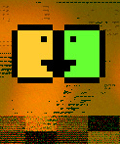
You Are How You Act
Locus Experimental Social Interface is an instant messenger, social experiment, and art piece that is built on the premise that you are how you act. By examining how you and your friends talk with each other, Locus automatically tries to find likenesses between your friends. You can then see these potential relations mapped out for you! You can watch your social web grow as you speak.
And trying out Locus:ESI is simple, Locus adapts to your life. There's none of this "Ask all your friends to join" nonsense, Locus lets you use your pre-existing instant messanger accounts. AOL? ICQ? MSN? Yahoo? No problem! [via Rhizome]
Posted by jo at 09:40 AM | Comments (0)
March 15, 2005
The Transcultural Mapping Reader
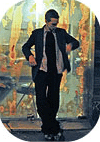
Setting a Boundary for Locative Media
This prototype category 'locative media', a term coined by Karlis Kalnins, was explored at a cross-disciplinary workshop at K@2 in Karosta, Latvia in late summer of 2003. Following discussions in Karosta, a series of Transcultural Mapping workshops were initiated by Rasa Smite and RIXC as part of the E.U. culture 2000 programme...Following the Transcultural Mapping (TCM) open call for papers Rasa Smite and Marc Tuters selected and edited texts for printed publication...and Rasa and Ben Russell put together this online TCM Reader, an extended collection of the raw unedited texts. The TCM Reader can be read as setting some boundary stones for the test category of locative media.
Posted by jo at 02:16 PM | Comments (0)
“The King Has...”
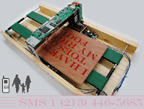
Display Your Secrets via SMS
We all carry secrets we cannot reveal. Taking its name from the famous fable "The King Has Donkey's Ears," The King Has..., by Krister Olsson, gives individuals an opportunity to unburden themselves of stressful secrets--be they their own or those entrusted to them by another person--by displaying the secrets in a public space under the veil of anonymity.
SMS a secret to 1 (213) 446-5685 (US). You will receive an automated message confirming receipt of your secret. If your secret is too long, you will be asked to shorten it and resend it. Your secret will be printed on a piece of wood using a specially designed slab printer. This piece of wood will be mounted on scaffolding at the heavily foot-trafficked stretch of 6th St. between Los Angeles St. and Main St. in Downtown Los Angeles. [blogged by emily on textually.org]
Posted by jo at 02:08 PM | Comments (0)
IN Network

Sleep Webcast
April 15, 2005: From their bedtime at 11PM in Los Angeles, and 2AM in New York, until they wake eight hours later, the artists Michael Mandiberg and Julia Steinmetz will sleep together on the phone. Separated by three time zones and 3000 miles, they curl up in the same sonic space. Connected via cell phone, they will hear the sound of each other breathing, tossing and turning, snoring, etc. This audio will be webcast in real-time as they sleep.
IN Network Sleep Webcast Schedule:
Tuesday, April 15th, roughly 11PM PST to Wednesday, April 16th, roughly 7:30AM PST; Wednesday, April 16th, roughly 9PM PST to Thurs, April 17th, roughly 5:30AM PST; Tuesday, April 22nd, roughly 11PM PST to Wednesday, April 23rd, roughly 7:30AM PST; Wednesday, April 23rd, roughly 9PM PST to Thurs, April 24th, roughly 5:30AM PST
This sleep webcast is part of IN Network their month long extended cell phone life-art performance about distance, communication, intimacy, telepresence, and living together while apart. In August 2004 Michael moved to New York; Julia remained in Los Angeles, postponing her move until the end of April because of commitments to her job and her collaborative art practice. Faced with most of a year apart, one of the things they did was switch both of their cell phones to a provider with free "IN Network" service.
Michael and Julia started out having normal conversations, giving each other updates about their days, and sending cameraphone pictures back and forth, etc. As they switched to using hands-free microphones, they began using the phone differently. What began as a pragmatic attempt to make their relationship last the separation through good communication, turned into something less about communication and more about intimacy and presence through technology, and sharing sonic-virtual space.
During the month of March the artists are presenting this cell-phone life-art performance via a Photo Moblog and Podcast on Turbulence.org. In addition to these webcasts, the IN Network site will host a Podcast of recordings of their phone conversations, and all of their text and picture messages.
IN Network Sleep Webcast:
http://turbulence.org:8080/ramgen/encoder/mandiberg.rm
Free Real Player (Required for webcast):
http://www.real.com
IN Network Website
http://turbulence.org/works/innetwork
IN Network Podcast (RSS 2.0 Feed)
http://turbulence.org/works/innetwork/mp3/rss.xml
Contact Info
juliasteinmetz -at- yahoo -dot- com
michael -at- mandiberg -dot- com
IN Network is a 2005 commission of New Radio and Performing Arts, (aka Ether-Ore) for its Turbulence web site. It was made possible with funding from the Jerome Foundation.
Posted by jo at 01:05 PM | Comments (0)
Treasure Hunt
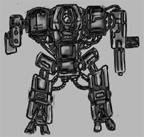
Game Zone
Treasure Hunt is a location based mobile phone game that uses GPS and internet enabled handhelds. We have hidden an imaginary treasure somewhere in your game zone and you must attempt using the clues we give you to try and find it. All players begin the game with one video or picture clue, and a number of multiple-choice answers, only one of which is the correct answer. Be careful when answering the clues, if you answer the clue incorrectly your next clue won’t be so helpful in your quest for the treasure, instead you might find yourself going in circles.
Posted by jo at 09:33 AM | Comments (0)
March 14, 2005
MARCEL
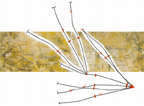
Interactive Network
MARCEL is a permanent broadband interactive network and web site dedicated to experimentation and research across the fields of art, science, education, technology and industry.
The network is made up of research centres, media labs, museums, arts organisations and arts practitioners who facilitate research, projects and collaborations which make use of high bandwidth networks - looking towards a future where fully interactive, virtual online experiences are as commonplace and user-friendly as today's relatively static internet.
Jerome Turner is the new researcher for the MARCEL Resources database, which will provide information on MARCEL related fields, events, projects and developments. If you would like to be included in the database, or suggest relevant material, go to MARCEL to find out more or email jerometurner(at)dsl.pipex.com
Posted by jo at 05:30 PM | Comments (0)
Feelings Are Always Local

Open Systems: Networks
Feelings Are Always Local by Dan Gillmor; V2_Publishing/NAI Publishers; ISBN 9056624237:
The network concept and its cultural fallout are still far from fully understood. Analyzing sets of entities which relate to one another communicating intensely with the outside world means to be ready to cast a different light on environments which, until now, were considered closed systems. In fact, the fundamental difference between 'system' and 'network' is that the former is wholly defined by the relations between its elements, and is intrinsically coherent, while the latter expands and communicates in every direction without losing its coherence. Thus, networks, seen as 'open systems', can be decoded in new ambits, such as the social dynamics in urban environments, the roads taken by scientific discoveries, specific natural ecosystems or the incredible collabirative heap of neurons inside our brains. [from neural.it]
This text, written as a catalogue of the DEAF 04 exhibition, interlaces these themes with the description of the installations, but with a particular attention to networks and their intrinsic contradictions, such as the production of new types of RNA and proteins between the brain cells which implement the memory functions and the great rise in the quantity of information meant to exercise control, proportional to the general rise in the size of the infosphere. This wide perspective makes possible to break free from the social evolutionist theory and to follow paths of thought which connect and intertwine, generating complex visions, necessarily multidisciplinary.
Posted by jo at 11:14 AM | Comments (0)
300 Square Mile Recording Studio

Teleconcert
In 300 Square Mile Recording Studio, Stanford University's student Mariachi Ensemble performed in a live, distributed recording session as part of the Fall AES Meeting in San Francsico. Three sites in the Bay Area (map) were connected for this professional audio "teleconcert" collaboration. The audio signals were transported with extremely low latency using research software and regional internet (CENIC).
Three musicians in each of the three sites performed together for a Halloween session on October 31, 2004. The main stage was at Genentech Hall on the new UCSF campus, and the two other trios were located at UCB (CNM) and Stanford (CCRMA). 300 Square Mile Recording Studio was a co-production of Chris Chafe, Jason Bryant and the SoundWIRE group at CCRMA.
Posted by jo at 07:19 AM | Comments (0)
mapping performance

Performance
Here, here and...here (2003) [Duration 40 mins DV Cam] A 40 minute performance/drawing at the ICA in in London. The piece was made prior to, and was part of, a lecture on "Locative Media and Performance". "Here, here and ..here" used a GPS to globally position the ICA and drew the information from the GPS screen onto the pavement in white chalk - mapping the ICA using 3D GPS Location and coordinates.
On either side of the drawn GPS screen are two other sections drawn in dotted lines. These show the variations of the coordinates on either side of the doorway, which suggest the infinite and ongoing grid of coordinates beyond this location.
The screen and drawing included; numbered satellites; position of satelites; accuracy; elevation; along with bars to show satellite strength, and a date, and time. The seconds on the time, were the last thing to be written – giving a precise time, using an atomic clock, to mark the conclusion of the piece.
Posted by michelle at 03:18 AM | Comments (0)
networked objects

Objects: In-Between Wearables and Environments
Potent Objects is a series of interactive objects that questions simplistic tropes of interaction while referencing the deeper emotional states implied by the physical grammar of interactivity. The objects explore our social anxiety about machines that can feel or emote, and our complex feelings about interacting with these machines. Are our machines becoming more like us as they learn to sense more about our actions, or are we becoming more like them as we tailor our actions to their limited sensing abilities?
Through the use of double entendres and plays on words, Potent Objects examines the tropes of interactivity as metaphors for human emotion. Each object is based on a word that refers to both a physical gesture and an emotional state. Some objects will try to 'learn' about certain emotions or interactive behaviors by capturing and incorporating users' actions into the object's own repertoire of 'emotion'.
Completed objects include Shaken and Balance. Other metaphors I might explore include: "held", "hidden", "blown away", "slip of the tongue", "thrown for a loop", and "leap of faith".
Shaken, 2003
In the Shaken object, the physical gesture of shaking the device initiates the objects response of being 'shaken'. This object consists of a snow globe with an embedded LCD screen and tilt sensor. The more the user shakes the object, the more momentum is added to a video of a woman shaking out of control. Future versions of this piece will incorporate video clips which evoke a first person depiction of being shaken or disorientated.
Balance, 2003
The Balance piece consists of a 4"x6" LCD screen mounted vertically on top of a copper pole. The pole is attached to a scale-like base with long arms and sliding weights. Adjusting the weights along the arms affects the video on the LCD, causing a woman to careen off screen or to stabilize her fall. The tilt of the object in either direction corresponds to the degree the woman has fallen towards the floor. When the object is balanced, the woman comes to a stable position atop the object's fulcrum.
Posted by michelle at 02:36 AM | Comments (0)
March 11, 2005
SEED
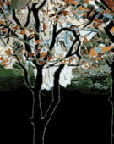
Art and Environmental Activism Converge
The Canadian Film Centre’s Habitat New Media Lab in collaboration with the SEED Collective will unveil an innovative interactive art installation, SEED, during the –scopeNew York Art Fair, March 11th to 14th at Flatotel, 135 West 52nd in New York City. This public interactive art installation invites participants to use their cell phones to plant "seeds" to grow a virtual forest.
"SEED is the first cell-phone driven interactive installation whose purpose is to effect environmental change in the real world. The ultimate goal of this evolving project is to buy a virtual tree seedling to plant in this installation; your cell phone provider will bill you, and the proceeds will be used to reforest certain endangered portions of our planet," said Napoleon Brousseau, artist and founding member of the SEED Collective.
"It is rare to see interactive art projects that have such a direct impact on the health and well-being of the environment. Habitat is thrilled to be co-producing SEED and sees this version as just the beginning of a much larger project – one that will include software tools being developed, formal collaborations with other institutions and the creation of a new type of art collective dedicated to environmental interventions," said Ana Serrano, Director, Canadian Film Centre’s Habitat New Media Lab.
SEED explores the convergence of rich media and wireless technology in the creation of a collaborative and evolving work of art. Through sound and imagery users create and populate a forest together. By dialing a particular number, each audience member will be given a “seed” to grow using the keypads of their cell phones. With each punch of the keypad, audiences have the ability to grow their seeds, choose the type of trees they want to plant, and change their texture and colour. After the three days at the scopeNew York Art Fair, the end effect is that all trees created by audience members will reveal a virtual forest.
Founded in 1988, by Academy Award winning director Norman Jewison, the Canadian Film Centre is Canada’s foremost film, television and new media institution dedicated to advancing Canadian creative talent, content and values worldwide through training, production, promotion and investment. Visit our website at www.cdnfilmcentre.com.
The Seed Collective is comprised of a group of artists, and producers, including founding member artist Napoleon Brousseau, Gabe Sawhney, and Galen Scorer; and producers Caitlin O’Donovan and Ana Serrano. More information can be found at http://www.seedcollective.ca
Posted by jo at 09:29 AM | Comments (0)
PLAN
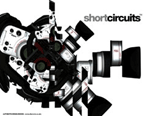
Reflections on the PLAN Launch
"...What is locative media? Judging from the PLAN gathering, locative media is the implementation of any context sensitive mobile technology – GPS, Bluetooth, wireless broadband, Sensors, RFID, etc. – to the end of actively examining and shifting how we interact with our physical environment and with each other. Projects span a wide range including social networking projects, walking projects employing digital mapping tools, and location aware games.
...Locative Media acts as an umbrella for a wide variety of post NetArt practices. As a genre Locative Media has limited currency. It will ultimately be subsumed by an increasingly integrated and ubiquitous computing infrastructure in our environment and by the prevalence of commercially oriented context-aware applications." From PLAN Report: Reflections on the Pervasive & Locative Arts Network launch at the Institute of Contemporary Art in London by Naomi Spellman, February 1-2, 2005, Net Art Review. [Related 1, 2, 3].
Posted by jo at 09:21 AM | Comments (0)
The Shape of Locative Media
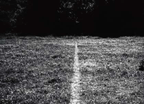
Mute, Locative Media and the End of Suburbia
The Shape of Locative Media, by Simon Pope MUTE 29:: 9.02.05.
"...(W)hat I found most interesting in this article is the focus on spatialising practices, tactics and strategies. He draws out an interesting tension between locative media projects working on a tactical level by resisting 'official' histories (through, for example, public authoring) and at the same time being implicated in institutional strategies of funding, research and development. He also points at tensions between Situationism, especially psychogeography, and Conceptual art as they may play out in locative media projects:
"There’s a wilful skimming of the surface of psychogeography, taking it to mean an unconstrained movement in the streets, and apparently less of an alignment with the wider project of anti-urbanism. This can leave an impression of a practice whose relation to ‘the city’ is closer to the disinterestedness of Conceptualism than the supposed engagement of the SI...[Situationist] devices for mapping the interactions and perceptions of human desires onto Paris, for example, were driven not by chance, as were the preceding scorned Surrealist interventions, but rather as a direct and conscious operation on the city..." [blogged by Anne Galloway on purselipsquarejaw]
The map, for Conceptual artists, seems more useful as a simple, generic method for recording the spatial aspects of a sculptural practice on an expanded scale...This leaves me wondering how those developing locative media understand themselves to be implicated in the spaces that they construct, record and annotate..."
This certainly resonates with my own wondering about how Situationism is being applied to locative media and pervasive computing. I have noted in the past that I'm troubled by the use of superficial Situationism to justify playful design practices rather than for socially and culturally critical approaches to technology and urban life. I've also expressed bewilderment at the lack of discussion about how the structure of GPS, absolute positioning, computing algorithms etc. actually conflicts with more fluid (social and cultural) understandings of spatial experience..." Anne Galloway
Posted by jo at 08:02 AM | Comments (0)
March 10, 2005
Organum: The Game
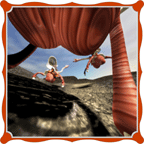
Anticipated Adaptations and Evolutions
Organum: The Game is being developed by a six-person team led by Greg Niemeyer and Chris Chafe; in the multiplayer game, users conspire with other organs that have been freed from their respective bodies, controlling game play through a collaborative vocal-input interface. The game is designed to encourage highly cooperative performance that combines real-world, embodied performance with virtual play.
Additionally, players' success in the virtual world of the game will hinge upon their willingness to register as real-life organ donors. We are conducting various organ donor drives in association with the production of all three Organum media projects." [via Jane McGonical's web site]
Posted by jo at 05:50 PM | Comments (0)
Co-Opticon
![]()
Democratic Optics
The Co-Opticon (a.k.a. the ShareCam) is a machine for democratic optics, allowing a network of participants to cooperatively control the viewpoint of a shared video camera. The co-opticon combines a networked robotic video camera with a graphical user interface that allows many internet-based viewers to share simultaneous control of the camera by specifying desired viewing frames. Algorithms compute the optimal camera frame based on all requests, and position the camera accordingly.
Posted by jo at 05:38 PM | Comments (0)
Games
Two More by Jane McGonigal
"ABSTRACT: Ubiquitous computing and mobile network technologies have fueled a recent proliferation of opportunities for digitally-enabled play in everyday spaces. In this paper, I examine how players negotiate the boundary between these pervasive games and real life. I trace the emergence of what I call “the Pinocchio effect” – the desire for a game to be transformed into real life, or conversely, for everyday life to be transformed into a "real little game.” Focusing on two examples of pervasive play – the 2001 immersive game known as the Beast, and the Go Game, an ongoing urban superhero game — I argue that gamers maximize their play experience by performing belief, rather than actually believing, in the permeability of the game-reality boundary." From A Real Little Game: The Performance of Belief in Pervasive Play by Jane McGonigal, Digital Games Research Associaton (DiGRA) "Level Up" Conference Proceedings, November 2003
"ABSTRACT: The increasing convergence and mobility of digital network technologies have given rise to new, massively-scaled modes of social interaction where the physical and virtual worlds meet. This paper explores one product of these extreme networks, the emergent genre of immersive entertainment, as a potential tool for harnessing collective action. Through an analysis of the structure and rhetoric of immersive games, I explore how immersive aesthetics can generate a new sense of social agency in game players, and how collaborative play techniques can instruct real-world problem-solving." From This Is Not a Game: Immersive Aesthetics & Collective Play, by Jane McGonigal, Digital Arts & Culture 2003 Conference Proceedings, May 2003.
Posted by jo at 05:25 PM | Comments (0)
PlaceStorming: Performing New Technologies in Context
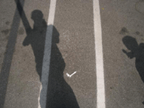
...Performative Aspects of Gaming
"ABSTRACT: We present PlaceStorming, an original method of brainstorming technological concepts, particularly in the area of pervasive computing. PlaceStorming is context-driven and play-based, combining real world environments with the immersive and performative aspects of gaming. In this paper, we discuss the background and techniques we used to create and deploy our method. Examples are drawn from a March 2004 PlaceStorming event to highlight key strengths of the method. Suggestions are made for what produces successful PlaceStorming sessions." From Place Storming: Performing New Technologies in Context by Ken Anderson, Intel Research, and Jane McGonigal, University of California at Berkeley. Proceedings for the 3rd annual Nordic Conference on Computer Human Interface (NordCHI 04)
The PlaceStorming project is a collaborative, pervasive play scenario that uses GPS data, mobile network technologies, and digital media devices to facilitate, as a public practice, context-aware and location-specific academic research. (Jane McGonigal is) developing it in conjunction with a Vectors fellowship from the University of Southern California. The technologies and media employed for v 2.0 are: text and Instant messaging; cell phones; handheld Global Positioning System devices; digital cameras; Web-accessible database.
Posted by jo at 05:23 PM | Comments (0)
Questioning: a reflection on the Demonstrate Project

Found Questions
"ABSTRACT: This reflection on the Demonstrate project, a public and collaboratively-controlled state-of-the-art robotic web camera installed in historic Sproul Plaza, features a selection of user-generated questions, taken directly from the captions of user photos and from the user comments that appear below photos in the Demonstrate archive. They have not been edited, and they appear in the same chronological order in which they were originally asked. Together, these “found questions” are intended to evoke the sense of playful inquiry, practical curiosity, political engagement, sense of audience, and self-reflexivity that developed within the Demonstrate community. Their unfolding over time captures the shifting dynamics that emerged among users, and between the watchers and the watched." From Questioning: A Reflection on the Demonstrate Project, written for Making Things Public, an art-technology exhibition at ZKM Karslruhe (March 2005). Collaborators on the Demonstrate project and exhibition: Ken Goldberg, Dezhen Song, Andrew Dahl, Jeremy Schiff, Irene Chien, Jane McGonigal and Kris Paulsen.
Posted by jo at 05:17 PM | Comments (0)
Notes Toward a More Pervasive Cyberdrama
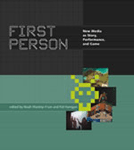
The Nomadic, Embodied, Embedded Aesthetic
"What would cyberdrama look like off the computer screen? To put it another way: Could there be a more pervasive cyberdramaturgy? Computing is increasingly ubiquitous and mobile. Why shouldn’t cyberdrama be, as well? Imagine a set of scripting, design and production strategies that employed digital technologies but tended toward a more nomadic, embodied, and embedded aesthetic. What might we learn about the dramatic potential of cybernetic systems and new media — or about the cybernetic potential of modern drama — from performances developed along these more pervasive guidelines?" From Notes Toward a More Pervasive Cyberdrama by Jane McGonigal, Electronic Book Review, June 2004 (in response to Cyberdrama by Pat Harrigan and Noah Wardrip-Fruin from First Person).
Posted by jo at 03:51 PM | Comments (0)
Google Maps
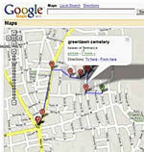
Google Mapping Location-Based Narratives
"My colleague Ken Tompkins recently sent along a link to John Udell’s Walking Tour of Keene. The short video demonstrates how Udell used Google Maps in concert with a bookmarklet to create a walking tour of an area in his hometown that rides on top of the Google Maps UI. Waypoints are marked with GPS data on the Google map and then linked to his content (jpgs and quicktime clips). Udell explains how he did it in a followup post. Other hacks to Google Maps are being posted on a Google Maps Hacking Wiki. Although the current hack is kludgey, it suggests exciting possiblities for location-based narratives that could be delivered in a web browser via the Google Maps interface." [blogged by scott on Grandtextauto]
Posted by jo at 10:03 AM | Comments (1)
March 09, 2005
America Needs a New System for Supporting the Arts

New Intervention Strategies Required
Bill Ivey, former chairman of the National Endowment for the Arts and now director of the Curb Center for Art, Enterprise, and Public Policy at Vanderbilt University, calls for "a new model for building a vibrant arts landscape." He argues that the more than 40-year-old system of non-profits and matching grants has gone about as far as it can go, and that it's time to take on new challenges: "draw a bigger, more-inclusive map of America's arts system, redefine the 'public interest' in relation to the arts, and identify new points of leverage and new intervention strategies." From America Needs a New System for Supporting the Arts, Chronicle of Higher Education, February 2005 [via Center for Arts and Culture Cultural Policy Listserv, March 9, 2005]
Posted by jo at 05:21 PM | Comments (0)
Building a Mobile, Locative, and Collaborative Application
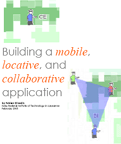
Catchbob Post Mortem
"I wrote a non-academic, post mortem type of document--Building a Mobile, Locative, and Collaborative Application [PDF]--on a treasure-hunt type, Wi-Fi based locative and collaborative mobile game I developed at the Swiss Federal Institute of Technology Lausanne.
The document describes the whole development process, from the technical architecture to the user perception of the game. I talk about the positioning system, the data, the communication tool as well as the user interface. It addresses a large audience. Techies and non-tech-savvy people should not be afraid to have a glance at it." - fabien [via Locative]
Posted by jo at 04:30 PM | Comments (0)
Habitat Perspectives
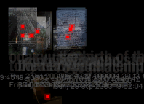
Space=Network of Places
In Habitat Perspectives you can follow the participants live as they post images to this application from the road through GPS enabled mobile media. The target is to conceptualise how the perception of the city differs from participant to participant depending on their everyday habits. Though in the beginning only a black background will predominate in the application, as participants post more and more content, a map of the city, and the map of each of the participants' "places" will slowly start emerging.
"Place is a special kind of object. It is a concretion of value, though not a valued thing that can be handled or carried about easily; it is an object in which one can dwell. Space, is given by the ability to move. Movements are often directed toward, or repulsed by, objects and places. Hence space can be variously experienced as the relative location of objects or places, as the distances and expanses that separate or link places, and - more abstractly - as the area defined by a network of places." Yi-Fu Tuan
Posted by jo at 12:45 PM | Comments (0)
Dérive=Drift
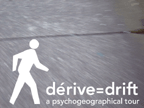
A Psychogeographical Tour
"(In Dérive=Drift: a Psychogeographical Tour) six subjects engaged in systematic derives. (A term coined by the French Situationists that translates, 'to drift'.) The subjects went on walks around the neighborhood of SE Belmont in Portland, OR. The focus of the trip was on the journey, and as such no destination was set. The subjects recorded their observations and emotions, using the PML model as defined by socialfiction.org.
The following demonstration is a collection of their experiences. It aims to create a new map of the city, based on the collective experience of those that inhabit it."
Posted by jo at 12:33 PM | Comments (0)
Augmenting Expectation in Playful Arena Performances with Ubiquitous Intimate Technologies

The Performance Triad Model
"Use of modern technologies in performance is not new. Laurie Anderson (Anderson), Kraftwerk (Kraftwerk), and Stelarc (Stelarc) have all paved the way for recent innovations in the cross fertilisation between performance and technology including body-worn sensors, mobile and wearable computing, directional audio and interactive projections. These innovative technologies allow us to integrate the corporeality of live performance with both remote and mediated presences. As we become more familiar with these technologies, and as these technologies become both more affording and more affordable, their use is becoming more diverse and widespread. The growth in this field has gone hand in hand with the increasing number of performances that seek to investigate and redefine notions of performance and performativity as essential human activity that can occur beyond the tightly bound world of the theatre building." From Augmenting Expectation in Playful Arena Performances with Ubiquitous Intimate Technologies by Alice Bayliss, Jennifer G. Sheridan & Simon Lock
Posted by jo at 11:54 AM | Comments (0)
CITYCLUSTER

From the Renaissance to the Gigabits Networking Age
CITYCLUSTER is a virtual-reality networking matrix, a creative high-tech container with original technological features, navigation, interactivity and graphic and content style. In which multiple environments, ambiences or cities both real and imagined, can be hosted, coexist and be interrelated within themselves through a common, virtual territory, interconnected by high-speed network, enabling remote participants to interact and collaborate in shared environments.
The framework may be expanded, modified, enriched, developed, and produced ad hoc in accordance with the nature and typology of the environment to be incorporated. Visitors, with their own creativity and communicative skills, can become protagonist and/or free citizen: navigate, interact, intervene exchange buildings, objects and ideas and or create their own ideal environment.
Posted by jo at 11:30 AM | Comments (0)
March 08, 2005
Confessions of an eBay Artist

Auctioning Time + Choice
"I am selling my day, March 19th, on eBay. Why? Because March 15th seemed like a bad idea. I will be starting with my breakfast, then dividing the day into blocks of times and events that buyers can choose for me to do, and end with an auction for my bedtime...
...the ebay passageways are seemingly infinite, in a choose-your-own-adventure format. Inspired by this idea, I decided to list things that the buyer could choose. "Settle the Dispute: Catherine wants to paint the bedroom pink. Guido wants to paint it white with red spray paint graffiti accents. The winner decides, and will receive a photo documenting that their decision has been carried out." For that listing I found imagery of walls from around the world—the Berlin wall, the Great Wall of China, the Western Wall in Jerusalem, Iraqi walls with graffiti of mullahs, aerial maps of walls, and internal diagrams of walls...
...I realized bidding is a complex means of communication when I learned that two of my bidders are a mother and daughter who aren’t talking with each other, but are both bidding on current auctions, including pictures of my breakfast, lunch and dinner, and 100 pictures of Condoleeza Rice..."
From Confessions of an eBay Artist by Guido Catherine, Big, Red & Shiny, Issue 19.
Posted by jo at 05:34 PM | Comments (0)
VibroBod

Creating Visceral Personal and Social Interactions in Mediated Spaces
VibroBod [PDF] allows two users to communicate feeling; hand gestures and vocalizations made by one user convey emotional content to the other user. VibroBods rest on the laps of individuals having personal conversations via phone, chat or instant messaging, to amplify moods or tones that may otherwise be lost. The design intent was to facilitate awareness, empathy, and emotional influence across mediated channels. (…) In informal critiques with fifteen students and faculty, we found that the VibroBod indeed provoked strong reactions. At first, people were hesitant to place their fingers in the holes and were alarmed by the vibrations. As users learned how their actions were affecting the VibroBods’ behavior, they became very involved and attentive in experiential discovery and in trying to evoke particular vibration patterns that seemed like accurate representations of how they were feeling. [blogged by Nicolas on pasta and vinegar]
Posted by jo at 11:01 AM | Comments (0)
Performance Paradigm

New Online Journal
NOTE: you'll need to register to gain access to this journal.
"For the last decade or more media technologies and live performance have become increasingly interrelated and interdependent. Debates about this critical nexus have resulted in a diversity of views. While there is broad acknowledgement that this interpenetration has resulted in widespread innovation, there is also evidence of a certain anxiety about the status of live performance. Questions have often focused on the resultant status of the live body, the changing nature of the performance experience and of technology itself. The experience of the ‘live’ based on notions of presence is often promised and reinforced by the effect of a mass audience, but it is increasingly susceptible to digital subversion by the temporal disintegration and restructuring of audio and visual data." From the Introduction by Edward Scheer and Peter Eckersall to the inaugural issue of Performance Paradigm. [via Christy Dena's post Scholar has moved into Jupiter Green]
Posted by jo at 08:20 AM | Comments (0)
dotdotdot
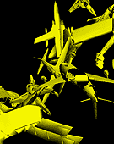
Glimpses of Unseen Places
A landscape from beyond the edges of the browser window that gives glimpses of unseen places. dotdotdot is constructed using several different motion capture systems and improvised performances creating abstract digital portraits. These animated avatars move and react to players inputs within an online virtual environment.
"dotdotdot provides a good example of the ways in which practitioners using old media and new media can collaborate to produce an ongoing body of work challenging the canons from which each component of the work orginates. Using motion capture, web tools, animation, games engines, sound and movement dotdotdot presents a series of animated interactive vignettes. These can be manipulated in terms of speed, sound, rotation and movement so that the basis of the range of visuals on offer stays the same but also so that the viewer/player can change them to accommodate their own preferences. [via Rhizome]
Each work has an Igloo signature but it allows the viewer to manipulate, play and be creative - after years of artists striving for truly interactive work, dotdotdot knowingly works with the limitations of interactivity in order to give the piece a characteristic style.
The viewer/player is presented with a range of choices involving genre orientated radio stations (you can choose drum & bass through to chart music) and a variety of visuals such as red, dot, bendy and plane. All these permutations and combinations together with the ability to interact with the animated figures in terms of speed and rotation challenge the viewer to think about the visual and audio styles in relation to their own experience of video, sound, animation and movement drawn from a variety of sources in day to day culture.
The project, which has been ongoing, is the product of Ruth Gibson, a dancer who is specifically looking at development of movement in the context of motion capture, and a programmer Bruno Martelli, who is interested in pushing the limits of technology in real physical contexts. The artists draw in expertise and collaborators as and when they need and the quality of the work is enhanced with every reworking. Their animations reflect these concerns with their 3D quality combined with recognisability of the human form in spite of the abstractness of the animated shape." Helen Sloan, Director - SCAN
Posted by jo at 07:38 AM | Comments (0)
March 07, 2005
Wearable Futures:
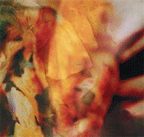
Hybrid Culture in the Design and Development of Soft Technology
SECOND CALL FOR PAPERS: Deadline for Abstracts: 14th March 2005
An event organised by Smart Clothes Wearable Technology Research Group, University of Wales, Newport and PDR, University of Wales Institute Cardiff in association with SCAN (Southern Collaborative Arts Network); 14 - 16 September 2005, University of Wales, Newport, WALES, UK.
Keynotes: Suzanne Lee, Senior Research Fellow at Central Saint Martins, Fashion, Consultant and author of Fashioning the Future pub Thames and Hudson Sept 2005; Joanna Berzowska, Artist and Assistant Professor of Design and Computation Arts at Concordia University in Montreal; Sarah E. Braddock Clarke, Lecturer, Curator and Writer. Co Author of Techno Textiles, SportsTech and Techno Textiles2 pub 2005; Chris Baber University of Birmingham, Reader in Interactive Systems.
This two day International conference will aim to contextualise the future potential of Wearable Technologies in a variety of fields ranging from military application to fine art.
Wearable Futures is an interdisciplinary conference, which aims to bring together practitioners, inventors, and theorists in the field of soft technology and wearables including those concerned with fashion, textiles, sportswear, interaction design, media and live arts, medical textiles, wellness, perception and psychology, IPR, polymer science, nanotechnology, military, and other relevant research strands.
We will be examining how some broad generic questions will be explored in relation to wearable technology including but not restricted to: aesthetics and design, function and durability versus market forces; the desires, needs and realities of wearable technologies; technology and culture; simplicity and sustainability; design for wearability; wearables as theatre and wearables as emotional 'tools'.
Key fundamental questions across the conference in relation to wearables are:
What is out there?
Who wants it?
What do they want?
How is it achieved?
Please submit an abstract of no more than 400 words in a Word document format by: 14th March 2005 to: hannah.topping @ newport.ac.uk
For further information please refer to the conference website.
Abstracts and full papers will be peer reviewed and if accepted published in the Conference Proceedings. A selection from the full papers will also be considered for publication in a themed addition of the international journal 'A.I. & Society' (SPRINGER).
Abstracts may be offered as long papers (30 minutes includes questions), short papers (20 minutes includes questions) or for poster presentations. Poster presentations are particularly welcomed from postgraduate students.
NB: Please note final submission for full papers has been changed to 6th June 2005.
Committee currently includes:
Chris Baber, Reader, University of Birmingham
Joanna Berzowska, Assistant Professor, University in Montreal
Sarah E. Braddock Clarke, Author & Lecturer
Julia Cassim, Helen Hamlyn Research Centre, Royal College of Art
Andrew Chetty, Arts Consultant
Carole Collet, Director Textile Futures, Central Saint Martins College of Art and Design
Joan Farrer, Reader, Royal college of Art
Frances Geesin, Research Fellow, London College of Fashion
Rory Hamilton, Interactive Design, Royal college of Art
Jane Harris, Senior Research Fellow, Central Saint Martins College of Art and Design
Ros Hibbert, Textile Consultant
Suzanne Lee, Senior Research Fellow, Central Saint Martins College of Art and Design
Alan Lewis, Director of Research, University of Wales Institute Cardiff
Jane McCann, Researcher, University of Wales, Newport
Stephen Scrivener, Research Professor, Central Saint Martins College of Art and Design
Mick Siddons, Consultant, CR8ive Solutions Ltd
Helen Sloan, Director, SCAN
David Smith, Reader, University of Wales, Newport
Posted by jo at 04:53 PM | Comments (0)
Presence
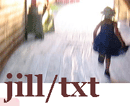
Flows of Moments>>Shared Presence
"Last night I was reading danah boyd’s post about how some people log on to IM to mark presence, while others only log on when they want to chat, and how the cultural difference causes tension, especially since it’s entirely invisible to those who log on simply to chat and assume everyone else does too.
Watching IN Network a similar thought occurred to me. There’s a stream of communication, but even when we can look at every single bit of communication and contact between two lovers (because it is all electronic and therefore accessible) the meaning of it evades us anyway. A conversation between lovers is uninteresting to others ("Tell me about your day?" "What kind of dinner did you get?" "Italian”) - but its mere presence is crucial to the couple themselves. [blogged by Jill Walker on jill/txt]
Howard Rheingold observes a similar shift from communication of messages to the communication of presence in the way cameraphones are used in Japan:
"The social role of the cameraphone is distinctly different from both the camera and the phone. And although these devices transmit images through the Internet, they are also turning out, rather unexpectedly, to be face-to-face media. It looks like this newly ubiquitous device could be more about flows of moments than stocks of images, more about sharing presence than transporting messages, and ultimately, more about personal narrative than factual communication. […] cameraphones represent a new opportunity to tell the story of our lives to ourselves as well as to others, and to share a sense of continuous, multisensory, social presence with people who are geographically distant. Cameraphones represent a new opportunity to tell the story of our lives to ourselves as well as to others, and to share a sense of continuous, multisensory, social presence with people who are geographically distant. […] Surveys in 2003 indicated that 90% of the people who responded viewed their cameraphone pictures on their handsets, 60% used them as wallpaper for the phone screens, over 50% e-mailed them to…[link]""
Posted by jo at 02:39 PM | Comments (0)
Project Research and Software Toys
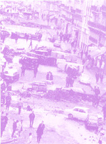
Miscellaneous
"...Situationist International Online: I’ve spent some good hours here recently. The situationists were anticopyright from the beginning, which has made this quite extensive archive of texts from the situationist movement which reached its height in the 1960s possible, including a complete archive of Internationale Situationniste and Guy Debord’s Society of the Spectacle.
Building a Mobile, Locative Collaborative Application: Documentation of the development of CatchBob, a treasure-hunt type, Wi-Fi based locative and collaborative mobile game. The game itself is fairly simple in concept:
The aim of the game for the participants is to find a virtual object on our campus and enclosing it in a triangle formed by their position. The positions are provided by a location-based tool running on a PocketPC or a TabletPC. This tool allows each person to see the location of his or her partners as an avatar on the campus map. Another meaningful piece of information given by this tool is whether the user is close or far from the object: an individual proximity sensor.
Lumiere Ghosting in the New Media Classroom: David Gillette describes a new media curriculum built around Lev Manovich’s The Language of New Media, and its focus on new media development as a form of interactive, multicultural cinema, and using a Cave-like display, the CompuObscura, an interactive new media art work that allows viewers to interact with images on display inside the device.
Jim Bugardner: the guy who invented the Palace avatar based chat system in the 1990s, has lots of generative art, doodads and neat little software toys at this site.
iStory Creator: an application made to allow people the opportunity to create their own iPod text games of the choose your-own-adventure variety."
[blogged by Scott on Grandtextauto]
Posted by jo at 11:07 AM | Comments (0)
Chris Barr is Available on Thursday

Body as Commodity
Chris Barr is Available on Thursday is a collaborative live art and documentary project. Events, actions, ideas, situations, etc. will be scheduled by the public for Chris every Thursday for the months March and April. Chris will perform the actions and events scheduled for him by the users of this web site. The schedule for each Thursday will be posted on this site in order to encourage the gathering of audiences and the recording of community documentation. This project is a stepping stone to investigate issues of authorship and collaboration, body and self as commodity, and artist as social organizer.
Posted by jo at 10:13 AM | Comments (0)
QUINTET.NET
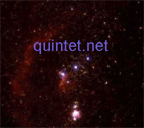
Full-Fledged Multimedia Performance Environment
A new version of the critically-acclaimed network-performance Quintet.net has just been announced. Quintet.net, which was called by computer musician Ian Whalley a highlight of the 2003 ICMC, now features an elegant brushed-metal graphical user interface and many improvements under the hood, such as network jitter compensation.
With its Viewer add-on, the application is a full-fledged multimedia performance environment with real-time notation, microtonal playback capabilities and a suite of authoring tools, the Composition Development Kit. Quintet.net is based on Max/MSP/Jitter and is available for free for both the Macintosh OS X and Windows platforms.
The Hamburg Network Composers' Collective, founded in 2003, is a permanent ensemble for the performance of compositions written or transcribed for Quintet.net.
Quintet.net was featured in the 2004/05 issue on network music of the Neue Zeitschrift für Musik (with CD-ROM) and in the current, February 2005 issue of Leonardo Journal.
More information is provided at http://www.quintet.net (the site was just updated and features background information on several international Quintet.net projects as well as network music performance in general).
Posted by jo at 08:00 AM | Comments (0)
Smart Space
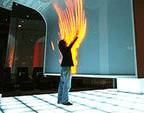
Responsive Architecture
At Bloomberg, one is confronted with a space that reacts in real time - "smart space" as it is called today in the new language of architecture. What is means is a constructed object that is sensitive, continually processes information and engages in a form of dialogue. Beneath the surfaces, processors are at work which process and convert the input received from a large number of electronic sensors.
Bloomberg, the international information agency, has created a small but fascinating showroom for its Tokyo business branch: 'Bloomberg ICE'. The name is its official title and stands for 'interactive communicative experience'. The result is a public, electronic-cum-architectural playground, a media folly as it were. [blogged by Martin Rieser on Mobile Audience]
The basic idea underlying the project is simple: the aesthetic and playful use of information. The intention is to translate stock-exchange data into formats that anyone can handle without any difficulty. Here, direct experience is intended to play a major role - information processing that can be experienced physically. In a country where toilets are computerized right up to the seat, where technology has no particular aura and grandmother is not afraid of automatic computer screens, such a concept can work.
For this idea, Klein Dytham and Toshio Iwai found a captivating metaphor: a greenish-white icicle ("ICE"), which is suspended freely from the ceiling in the middle of the showroom and acts as a data collector. The information whirring about in the (data) space condensates on the icicle, is compressed and finally ends up in a kind of "data showcase" at eye level. The swinging icicle, which swings overhead like a baldachin, turns out to be an object that can be experienced and manipulated: a room-sized glass display unit (5.0m x 3.5m), that provides some surprises when touched.
In stand-by mode, the icicle initially appears to be a normal data ticker. Without interruption, columns of numbers march over the surface. Depending on the current share prices, they climb upwards and expand on the LED display or they gradually shrink and disappear from sight altogether. Everyone can understand this: the ups and downs of Wall Street, yet another large investor bites the dust.
The real fun begins when the visitor approaches the glass wall. Infrared sensors underneath the surface detect the presence of the visitor and ask him to participate. "Touch here!" commands the wall but it also reacts without anyone directly touching it. The sensors are activated when the visitor comes within a distance of half a meter. The columns of numbers begin to flutter and fluctuate; a menu appears and offers various games - electronic volleyball, a wave generator or a digital harp, for example. The icicle can be used to play music synesthetically in that the sounds played are replicated on it in the form of brightly lit, colorful tree branches.
Artist:Toshio Iwai
Architects: Klein Dytham architecture
Client: Bloomberg
Completion date: October 2002
Location: 2-4-1 Marunouchi, Chiyoda-Ku, Tokyo
Posted by jo at 07:48 AM | Comments (0)
Interactive Video vs Performance Cinema
Live on Empyre, March 2005
From a post by Henry Warwick: "...I would also distinguish the difference between interactive video and performance cinema, and I would tend to question much of what constitutes the "interactivity" of "interactive" video, as much of what I see as "interactive art" (much less video) is not much more than various elaborations on a boolean if/then decision tree, which I find to be completely, and too often profoundly, UNinteractive...
...The other aspect that differs Live vs. Other Cinematic practices (interactive or otherwise) is a matter of synchrony vs diachrony. A movie is diachronous - it is essentially identical from one showing to the next. It can be shown to an empty theatre. It exists as a loop outside of time. A performance is synchronous - it will always differ from one performance to the next: even if the performance is a film and completely diachronous, the reaction of the audience will differ, making each performance unique. It exists Only in time...
As the internet allows a kind of fractal dimension of time (kind of like 1.2 D) where the arrow always goes forward, but it can stop for a while and skip around that which has occurred, it obviates most of the possibilities of any real live cathexis between the audience and performer through the vessel of the art and the environment of the art work itself by the very exigencies involved with what it is to use the internet..." Continue reading this post by Henry Warwick.
Source:
Message: 4
Date: Sat, 05 Mar 2005 00:04:28 -0700
From: Henry Warwick
Subject: Re: [-empyre-] interactive video software
To: soft_skinned_space, soft_skinned_space
Message-ID: Content-Type: text/plain; charset="US-ASCII"
Posted by jo at 07:35 AM | Comments (0)
DIGITAL CULTURES
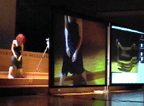
International Dance Technology-Lab 2005
The International Dance Technology-Lab 2005 will take place from 28 November - 4 December; it will be hosted by Nottingham Trent University's Future Factory in cooperation with Radiator Festival for New Technology Art, essexdance and other UK partners. The weekend conference and exhibition events are open to all.
Digital technologies challenge our techniques of dance and performance, customary perceptions of culturally embodied knowledge and sensory processing, and assumptions about choreography, composition, and the relations between maker, performer, and audience.
The central aim of this international lab meeting in November-December 2005 is to take stock of the evolution of contemporary dance (technology), and develop a new understanding of interaction design and physical computing in the dance and performance field through critical engagement with the consequences of interactivity on contemporary digital cultures.
We shall ask: whether interactive performance has become an instance of collaborative culture, beyond aesthetic conventions of concert dance, and how interactive media blur distinctions between performer and audience/user, between performance, play, ritual, game and utility.
Western knowledge of digital interactivity is examined through non-Western concepts of interaction. Non-western articulations of the digital provide a framework for fresh interpretations of participatory design. The cultural questions in this research lab derive from observations of multi-level collaborations between artistic, theatrical, technological, and research partners from different cultural backgrounds and locations, as well as from lab experiments with divergent perceptions of the sensory processing of the digital.
The theoretical scope of the project encompasses an analysis of "digital cultures" in interactive dance based on the findings of an international and cross-cultural lab with the participation of 20 or 25 distinguished choreographers, composers, performance and media artists, programmers, and designers. The lab workshop takes place at Nottingham Trent University over a period of one week and is closed to the general public.
The weekend conference and exhibition events are open to all.
Cross-cultural perspectives and digital art are the focus of the concluding Public Roundtables and Colloquium to be held at this confernece (Friday through Sunday, December 2-4, 2005).
Commissions for new work will be announced, and these will be on display throughout the week. The colloquium is organized in collaboration with the Radiator Festival for New Technology Art. If you wish to make a presentation on the subject of the Lab during the conference, please send us a proposal.
johannes.birringer @ ntu.ac.uk
Live Art - Digital Research
Nottingham Trent University
Victoria Studios - Shakespeare Street
Nottingham NG1 4FQ UK
http://art.ntu.ac.uk/performance_research/birringer/idat.htm
Posted by jo at 07:25 AM | Comments (0)
March 04, 2005
New American Radio
![]()
Online Archive Continues to Grow
New Radio and Performing Arts, Inc. is pleased to announce that 16 additional full-length works have been added to the New American Radio web site, bringing the current total to 132. Sixty additional works will be archived in the coming months.
"Experimental sound art pieces commissioned by New American Radio, weekly radio program distributed to public radio stations from 1987-1998, became available online this past spring. At some point, New Radio and Performing Art, Inc., the organization responsible for this great resource, hopes to make over 300 works by artists such as Pauline Oliveros, Christian Marclay, and Terry Allen available through its site." From Stationary Flow: Process and Politics in Audio Art On the Air and Online by Claire Barliant.
"The expansion of the NAR website provides a good opportunity to examine reasons why radio has held such fascination as a medium for many artists, and how relocating to the Internet affects work designed specifically for radio. Part of the appeal of art made for radio is in the tension created when an experimental artist tries to subvert the medium's mainstream status while simultaneously leveraging its capacity to reach a wide audience.
Radio, like all "new" media, is charged with meaning, i.e., unlike canvas, it is not neutral material, nor does it easily shed its association with mass culture. When it first appeared, it was originally heralded as a tool to aid democracy. This vision quickly changed when a dramatic increase of radio sales in Germany in the early 1930s signaled an opportunity to the fascist regime for a new method of distributing propaganda. "With the careful administration of the daily programming the scene was set for authoritarian control," Bruce Barber wrote of radio's history in 1990. "The emancipatory potential of the new communications medium had been denied in favour of its limitless capacity to order information in such a manner as to ensure the unilateral demonstration of power."
The trick for artists is in learning how to embrace the medium's tics while downplaying the message. John Cage was one of the first artists to whom traditional radio programming appealed on a purely aural level. In 1956, he composed a piece titled Radio Music that included up to 8 radios playing simultaneously. It is interesting to note how deeply Cage, from the perspective of a composer, appreciated the radio. "There's one station now on the radio, in New York, that reminds me of Satie and that is WINS," he said in an interview in the early 80s. "It's a continuous news station, and the program, if you listen long enough as you are driving along the highway, more or less repeats itself in the same way that the Vexations of Satie would be repeated, because you come back to the weather at regular intervals and, in fact, to the same headline news." Anyone living in the New York area will be familiar with the importance of repeating elements to the identity of 1010 WINS as a radio station: there is the constant grumbling static running underneath everything, the insistent, falsely energetic force of the announcer's speech, the relentless iterations of the station's slogan ("give us 10 minutes and we will give you the world"), the weather and traffic details. Cage heard the potential for art in the sounds made by the station as well as those it couldn't control. The intermediary sounds of radio broadcasting famously also drew the attention of the Futurists, who demanded that La Radia should utilize "interference between stations."
Other artists have capitalized on radio's political possibilities. In the late 1960s, artist John Giorno created the "Radio Free Poetry" project, in which he set up guerilla radio stations at St. Mark's Church and the Jewish Museum in New York City. Activist sentiment fueled the operation. Giorno hoped to inspire others to do the same, and circumvent FCC regulations in order to broadcast alternative points of view as well as literature that was not easily embraced by mainstream media. Giorno's work foreshadows today's telecommunications systems, and prefigures a possibly Utopian view of the Internet as presenting an opportunity for anyone to become a cultural producer. Tetsuo Kogawa, the Japanese radio artist who pioneered the idea of "micro radio," transmitting radio within a limited area of signal, wrote that increasing FCC constraints preventing pirate radio are best circumvented through the Net; in fact, he believes that even "big" radio will soon be obsolete. "Sooner or later, large and global communication technologies will be integrated into the Internet," he writes. "Radio, television and telephone will become local nodes to it."
Putting the NAR archives online raises many questions that are impossible to answer now. The sounds of static and station interference may one day disappear with the advent of digital FM radio. Will a work of sound art that features these standard radio tics sustain its power as these sounds fade into ancient history? Listening to radio art online implies that interest in the process of radio recording is waning, and artists are turning to new technologies. As it continues to make its archives available, perhaps the New American Radio website will provide answers to these questions and others that pertain to radio art. It is interesting to reflect on the history of radio art, while sound art on the Net continues to turn up new complications that echo issues raised in the past, and still grapples with challenges raised by the Futurists long ago. Honor Harger is one artist actively exploring the complexity of sound art on the Net. Of r a d i o q u a l i a ' s use of Real Audio, in 1998 Harger wrote that, "We celebrate the hidden spaces where the alchemic transference of intent and error happens." Now that New American Radio has been put out to pasture, so to speak, emerging artists coming into contact with its constructions may be further inspired to stake out territory for sound art on the Net as the artists on NAR did with radio." Claire Barliant
Also read New American Radio and Radio Art by Jacki Apple.
Posted by jo at 03:47 PM | Comments (0)
Imaging Place
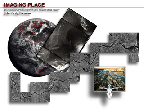
A Model Strategy for Collaboration
"Imaging Place--by John (Craig) Freeman--is a documentary virtual reality method, which uses a combination of panoramic photography and digital video to investigate place. Although the method borrows freely from the traditions of documentary still photography and filmmaking, the Imaging Place method departs from those traditions by using the emerging nonlinear narrative structures made possible by new interactive technologies and telecommunication apparatuses. It is exhibited primarily in alternative art exhibition spaces, museums and over the Internet. The work is projected up to nine by twelve feet in a darkened space with a podium and a mouse placed in the center of the space, which allows the audience to navigate throughout the project. When it is activated by the click of a mouse, the project leads the user from global satellite and vertical aerial perspectives to virtual reality scenes on the ground.
The user can then navigate throughout an immersive virtual digital video space. Rather than the linear structures of the novel or cinema, this new form allows the story to unfold in a meandering labyrinth of discovery and associations. The goal of the Imaging Place method is to document sites of cultural significance, which for political, social, economic or environmental reasons are under duress, at risk of destruction or undergoing substantial changes. This includes historic sites as well as sites of living culture which are being displaced by globalization and the collapse of industrial modernism.
Imaging Place is designed to accommodate interdisciplinary collaboration conducted across institutions and over distances. It uses new technology to bring disparate bodies of knowledge together through the investigation and documentation of place. The method attempts to bridge the gaps in understanding that exist between esoteric disciplines that have developed as a result of academic and industrial specialization. The technological tools are now available for bringing the work of experts together without sacrificing the depth and dimension of specialized knowledge and to connect the abstraction of highly specialized thinking with the visceral experiences of people on the ground. In addition to providing a form for the generation, dissemination and accumulation of interdisciplinary research and artistic production, the Imaging Place method provides a model strategy for collaboration."
Posted by jo at 08:10 AM | Comments (0)
ArtinCities
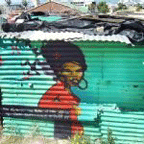
Mapping Cities Through Street Art
"Cities are like a huge art gallery with a permanently changing exhibition. Art is submitted everywhere and constantly. The art is not made by the direction of an institution or company, but are short personal notes, big fascinating projects or intriguing protests. With graffiti, posters, stickers, stencils, etc. the individual artists use the city as an art gallery.
ArtinCities collects the art by each city and wants to find out what is going on in the city. What moves the artists to use the city as a exhibition space? What are the reasons that the artist uses an illegal way to express him/herself? Are there trends (local, regional, international)? Which artists you can find in which city? How does the art spread around?"
Posted by jo at 08:05 AM | Comments (0)
2Wear

A Run Time for Adaptive and Extensible Wireless Wearables
"In the 2WEAR project we explore the concept of a personal system that is formed by putting together computing elements in an ad-hoc fashion using short-range radio. Certain elements are embedded into wearable objects, such as a wristwatch and small general-purpose compute/storage modules that can be attached to clothes or placed inside a wallet. Others have the form of more conventional portable computers, like PDAs and mobile phones. Also, there are stationary elements as part of the environment, some of which are visible, such as big screens and home appliances, while others are not directly perceivable by the user, such as network gateways and backend servers." [via del.icio.us/mlewis]
Posted by jo at 08:00 AM | Comments (0)
Geographies of Technology:
Space and Place as Aspects of Specific Actions
"In this paper I would like to investigate some of these issues, specifically focusing on the roles which ‘place’ and ’space’ play in discussions about the physical world. I will argue that some of the existing discussions on ‘place’ and ’space’ have over simplified this distinction. For Place and Space, rather than being easily identifiable aspects of the physical world, are actually the battleground over which much conceptual discussion has raged in philosophy and the social sciences. Exploring these arguments, and contrasting the ways in which place and space have been used, is an entry point into thinking about some aspects of technology’s existence, physical extension and incorporaton into human practice." Geographies of Technology: Some Comments on Place, Space and Technology by Barry Brown.
Posted by jo at 07:55 AM | Comments (0)
Going Anywhere, Being Everywhere:
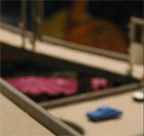
Metaphors of Mobility for Ubiquitous Computing
"Abstract | Full Text (PDF): If ubiquitous computing seeks to go anywhere and be everywhere, the challenge is to adequately design for context-awareness, where context is defined as fluid and unpredictable, and people, objects and meanings are all mobile. Various efforts in ubiquitous computing have sought to bring computers to "our world" (effectively domesticating them), rather than us having to adapt to the "computer world" (and domesticating us). But such simple dichotomies incorrectly assume there are easy distinctions to be made between the virtual and the actual, or human and machine. Metaphors of mobility from social theory and art draw attention to the mobile and stable elements inherent in the design and use of ubiquitous computing. I argue that a greater articulation of these elements is critical to understanding the foundations of, and future possibilities for, ubiquitous computing." [Anne Galloway, Paper for Concepts and Models for Ubiquitous Computing Workshop at UbiComp 2002, 29 September - 1 October, 2002, Göteborg, Sweden]
Posted by jo at 07:50 AM | Comments (0)
March 03, 2005
Receiver #12

Seamless Mobility?
Receiver 12 is now available. This issues includes Mobile Movies – Taking Film to the Public Space, by Heinz Hermanns; Beyond Just Getting There – The Interactive Road by Oskar Juhlin; Visions of Culture in the Era of Mobility by Ranjit Makkuni; and The City Shaman Dances with Virtual Wolves – Researching Pervasive Mobile Gaming by Frans Mäyrä.
Posted by jo at 06:22 PM | Comments (0)
CITYSNAPPER_Game
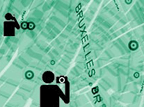
Build A Representation of Brussels
The CITYSNAPPER_Game--by LAb[au] and iMAGE z[ONE]/Olivier Vanderaa--is an urban interactive photographic game in real time, using an online 3D electronic space and SMS server technology, relating the urban space with the World Wide Web, and users (players) with an urban photographer. Players use SMS to instruct the photographer to go to a particular part of town and bring back a picture of it; orientate the shooting with additional verbal instructions (word, sentence, riddle); and record their response. The photographer takes a picture with a cell phone and implements the interface via SMS. The audience can follow the game through the online 3D interface from a home computer or by navigating the 3D model of the city screened in the exhibition space. At the players can retrieve a print of the image "they gave birth to."
Posted by jo at 04:33 PM | Comments (0)
Floatables
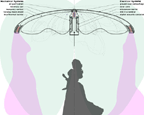
Spaces of Absence
Haque Design and Research asks the question "in an urban environment that is so data-saturated can a distinction between public and private space really claim to exist"? It is the contention of (Floatables) that private spaces are increasingly scarce. All spaces are public, except spaces of absence. If privacy once existed in the home, now such a space no longer needs to be tied to a particular location."
"...The aim of the floatable jellyfish-like vessels that drift around cities is to create temporary, ephemeral zones of privacy: an absence of phone calls, emails, sounds, smells and thermal patterns left behind by others. Through various electrical systems they are also able to prevent access of GPS devices, television broadcasts, wireless networks and other microwave emissions. Finally, by creating a "blurry barrier" and a ground-plane camouflage pattern, they provide shielding from the unembarrassed gaze of security cameras and surveillance satellites." [via]
Posted by jo at 01:34 PM | Comments (0)
Frequency 1550

Location-Based Mobile Games and Educational Content
"Waag Society is developing a 'mobile learning game' pilot together with IVKO, part of the Montessori comprehensive school in Amsterdam. It's a citygame using mobile phones and GPS-technology for students in the age of 11-12 (so called HAVO+MAVO basic curriculum). It is a research pilot examining whether it's possible to provide a technology supported educational location-based experience. In the Frequency 1550 mobile game, students will be transported to the medieval Amsterdam of 1550 via a medium that's familiar to this agegroup: the mobile phone." The pilot took place from 7 to 9 February and is supported by KPN Mobile's UMTS network. They promise to show more of the development process and the results of the pilot soon. [Posted by Adriana de Souza e Silva]
Posted by at 01:23 PM | Comments (0)
Cameraphones as Personal Storytelling Media
Distributed Co-Presence
"...Ito and Okabe's previous observations of Japanese mobile phone users led them to adopt a conceptual framework of "technosocial situations" in which people "assemble social situations as a hybrid of virtual and physically co-present relations and encounters." For example, the people they observed used streams of text messages to "inscribe a space of shared awareness of one another" -- an explanation for the preponderance of messages that conveyed no information other than what the sender was doing at the moment: "I'm sitting on the bus," or "I'm bored" or "I'm walking up the hill." The cameraphone study extends this framework by revealing how people's choices of images to share enables intimate social networks to share ambient information; but, "on the other hand, we are finding that users tend not to e-mail messages to one another, and prefer to share images by showing pictures on a handset screen." Hence, the communication device that used to transmit messages across distances is now also used to capture a flow of experience in order to add a visual element to face-to-face story-telling..." From Cameraphones as Personal Storytelling Media by Howard Rheingold, TheFeature, March 3, 2005.
Posted by jo at 10:16 AM | Comments (0)
Social Tele-Presence
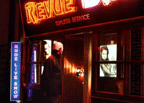
Rent-a-Body
"Tele-presence can be defined as the experience of being fully present at a live (non-virtual) location remote from one's own physical location. Effectively removing the visual and aural senses from the body’s location and having them operate in real time from somewhere else...
...In the same way that to a degree the eyes of a dog can enable a blind person to see, their legs can be used to enable people to walk whilst remaining stationary. In this way the user can window shop from home or take a walk in the country...
...Through the rent-a-body service the customer can rent the physical body of another person. The rented body effectively has his senses removed, he can see nothing and hear only the voice instructions of his user. His body becomes literally a host. This enables the customer to either visit ‘socially’ inhospitable, unethical places or to attend meetings or events without physically being there." From Social Tele-Presence by Auger-Loizeau
Posted by jo at 10:04 AM | Comments (0)
Framing the Ambiguous Wearable

The Undecidables
"Abstract: This article takes the concept of ambiguity as presented by Gaver, Beaver & Benford [1] as a tool to discuss what has been described as ‘undecidables' - conceptual art works in the domain of the wearable, which currently find themselves crossing the usual framing mechanisms of art, craft and design [2]. How practitioners choose to frame their work has implications for its interpretation. The physical object has a presence that can be hard to escape; it presents a reality already in existence, even as it suggests a possible future, and may even disallow the space between "looking at the work, and the prospect of using it" [3]. Some of the tactics used by conceptual practitioners in interaction design and contemporary craft to get around this problem are illustrated with a view to expanding the tactics for ambiguity offered by Gaver et al's original paper [1]." From Framing the Ambiguous Wearable by Sarah Kettley, Convivio Web-Zine, Issue 2. [blogged by Regine on 21f]
Posted by jo at 09:31 AM | Comments (0)
March 02, 2005
Joanna Berzowska

Second Skins
Joanna Berzowska was RISD's guest lecturer last night. She gave an impressive overview of both the 'wearables' field and of her own work. Amongst her many accomplishments, Berzowska is the founder of XS Labs (Extra-Soft Labs), "a design studio where we develop artifacts that are extra soft and react in weird ways to our bodies and our environments. We play, we experiment, we develop new technologies, we make art and we design products in the fields of physical computing, tangible media, electronic textiles and wearable computing." Their projects include Memory Rich Clothing, Inflatables/Deflatables, Animated Weavings, Addressable Textile Displays, Blazer:soundSleev and musical pants.
Wearables (also referred to as Electronic Textiles or Smart Fabrics) research is mostly funded and developed by the military, however there are many artists making "reactive clothes, second skins that can adapt to the environment and to the wearers, that can express aspects of their personalities, their needs and their desires, and represent aggregate social information."
Berzowska gave examples of other artists' work in the following three catgories: (1) Soundscapes, for example Saturday by Sabrina Raaf, and Sonic City; (2) Social Commentary, for example Lucy Orta's Refuge Wear and Medulla Intimata; and (3) Playful Garments, for example, Alison Lewis' Closer and Elise Co's Puddle Jumper. Berzowska stressed that practitioners need to consider why we want our garments to be electronic, and be mindful of their misuse (surveillance) as well as the environmental ramifications of mass producing such objects: "The killer app for wearable computing is to convey personal identity information. This is called fashion and it is mostly visual." (Berzowska). [Related]
Read ISEA Fashion (Wearable Computing) Report by Scott Rettberg.
Posted by jo at 03:57 PM | Comments (0)
YellowArrow at DiVA
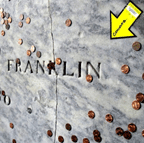
Art in Motion
Digital and Video Art Fair [DiVA] kicks off with an opening after party on March 10th that will definitely be an event in itself. The party will feature special performances by YellowArrow. Attendees are invited to participate in the art in motion. In addition to YellowArrow stickers’ distribution and projections displaying the content of the YellowArrow Global Gallery, mobile YellowArrows will point out a series of live micro performances staged throughout the party and announced via TXT messaging.
DiVA is the first art fair in the United States dedicated exclusively to digital and video art. DiVA will serve as an international destination for collectors, art dealers, museums, curators, and artists. Around forty galleries willfeature the diverse and innovative work of new media artists exploring and pushing the digital envelope. Digitally created work is a dynamic platform of expression in contemporary art that includes film and video, animation, photography, printmaking, sculpture, painting, architecture, and performance.
The YellowArrow is a global public art project that merges graffiti and sticker culture with wireless media, creating an interactive forum for people to leave and discover messages pointing out what counts in their environment.
Participants place arrows to draw attention to different locations and objects -- a favorite view of the city, an odd fire hydrant, the local bar. Each arrow has a unique code, and by sending a text-message (SMS) from your mobile phone to 1.646.270.5537 in the format "+code your message" you associate a short text with your arrow -- messages can range from literary quotations to personal commentaries to game-like prompts to action.
When another person encounters the arrow, he or she sends "code" to 1.646.270.5537 and immediately receives the message associated with it on their mobile phone. Through this location-based exchange of text-messages, the YellowArrow becomes a symbol for the unique characteristics, personal histories, and hidden secrets that live within our everyday spaces. And it's not just places, it's people: YellowArrow TXTshirts are individually coded just like the stickers.
YellowArrow text-messaging is currently compatible with all phones and service providers in the US as well as internationally with those networks under the GSM standard. The website, YellowArrow.org, allows participants to annotate their arrows with photos and maps and is the online gallery of YellowArrows placed throughout the world -- visit to order arrow stickers and tshirts and see announcements about new events and features.
Posted by jo at 11:16 AM | Comments (0)
March 01, 2005
IN Network

Living Together While Apart
IN Network--by Michael Mandiberg and Julia Steinmetz--is an extended cell phone life-art performance about distance, communication, intimacy, telepresence, and living together while apart. Faced with the prospect of a long-distance relationship when Michael moved from Los Angeles to New York in August 2004, the two artists got their frequent flyer numbers handy, and switched both of their cell phones to a provider with free "IN Network" service.
During the month of March the artists will present this cell-phone life-art performance via a photo moblog and podcasts of their phone conversations. There will also be several live webcasts of audio of the artists sleeping together on their cellphones. They will route all of their text and picture messages through the IN Network website. If you'd prefer, you can have installments of the performance sent directly to you via their Podcast. How to Podcast?.
"IN Network" is a 2005 commission of New Radio and Performing Arts, (aka Ether-Ore) for its Turbulence web site. It was made possible with funding from the Jerome Foundation.
BIOGRAPHIES
MICHAEL MANDIBERG is a new media artist who uses the internet, video and performance to explore subjectivity, labor, and commerce. His projects include "Bush Poll," a statistical survey of the 170 George Bushes of the United States, 2004; the DVD exhibition "First Person" in collaboration with Carla Herrera-Prats and Anne-Julie Raccoursier, 2003; and "The Exchange Program," a collaborative performance, 2002. Mandiberg has exhibited at Ars Electronica Center, Linz, Austria; ZKM in Karlsruhe, Germany; Transmediale Festival, Berlin; Tirana Biennale, Albania, and C-Level, Los Angeles. His work has been reviewed in The New York Times, The Chicago Tribune, The Berliner Zeitung, Wired, and a new survey "Internet Art" published by Thames and Hudson World of Art. Mandiberg is Assistant Professor in the Department of Media Culture, at the College of Staten Island/CUNY. URL: http://www.mandiberg.com/; Contact: michael -at- mandiberg -dot- com
JULIA STEINMETZ is a founding member and co-director of the Toxic Titties, a Los Angeles based collective working in performance, video, photography, and new media. Their work has been performed at such venues as Museum On Contemporary Art, Seattle, REDCAT at the Walt Disney Concert Hall, Out Fest Film Festival Los Angeles, LA Freewaves festival and the Hammer Museum in Los Angeles. Titties have performed in events such as the "Intersectional Feminisms" conference at UC Riverside, CA and at "Outside Field: International Performance Festival" at Ex-Teresa Arte Actual, Mexico City, "Cyberfem Spirit," at Edith Russ Site for New Media, Oldenberg, Germany and at Schnitt Ausstellungsraum, Cologne. Their work has been written about in Tema Celeste, the Los Angeles Times, the LA Weekly, Mexico City's La Reforma, Black Book Magazine, and Kolner Stadtanzeiger. Toxic Titties performance documents and design work have appeared in "Gendered Geographies," edited by Kaucyila Brooke, and "SITE, Schinitt Austellungsraum" published by Krefeld, Germany. Their work in collaboration with Austrian artist Dorit Margrieter was recently featured at MUMOK in Vienna. Contact: juliasteinmetz -at- yahoo -dot- com
Posted by jo at 11:53 AM | Comments (1)
Internet2:
Orchestrating the End of the Internet?
"Anyone who wonders how the Internet will die will find one possible scenario in the recent decision by the Internet2 consortium to bring Hollywood into the design process for our next-generation Internet.
Hollywood is on a roll. In a fraction of the time that it took the music industry to emasculate Napster, the Motion Picture Association of America has managed to shut down the highest profile file-sharing sites (Suprnova and LokiTorrent) and begun to sue its own share of college students. More importantly, the MPAA recently persuaded Congress to legislate something their fellow lobbyists in the music industry never managed to achieve: a copyright control device in every player. By this July, every DVD player and TiVo box will sniff for a "broadcast flag" that prevents it from copying digital TV broadcasts. This hardware intervention effectively destroys even the possibility of fair use, since artists and educators cannot transform, parody, or criticize what they cannot record. [via Rhizome]
The Electronic Frontier Foundation is mounting a noble campaign to grandfather a compliant tuner before the legislation takes effect [1]--but in the meantime the MPAA has set its sights on its next acquisition: the ultra-high bandwidth Internet2, which runs on the 10 gigabit per second Abilene backbone:
"We've been working with Internet2 for a while to explore ways we can take advantage of delivering content at these extremely high speeds, and basically manage illegitimate content distribution at the same time," said Chris Russell, the MPAA's vice president of Internet standards and technology. "Those would go hand in hand." [2]
To judge from the statements of Internet2 bigwigs, their technologists have already capitulated before the battle has even begun:
"This wraps together the broad interest we have in working with our members and potential members on advanced content delivery," said Internet2 Vice President Gary Bachula. "Obviously we're interested in making sure that's legal and safe." [2]
The presentations I've seen to date from the Internet2 consortium, from music classes taught by "master" conductors [3] to biometric and authentication applications for "managing identity" [4], suggest that Internet2 is a broadcast organization in network clothing. While it's doubtful that everyone at work on Internet2 shares this vision, the consortium's choice to "collaborate" with the MPAA could give media conglomerates a chokehold on the 21st-century Internet.
The stated goal of this collaboration--to investigate new business models for streaming movies--sounds reasonable until you read that Internet2 is already capable of transmitting a DVD movie from Switzerland to Tokyo in under 5 seconds. (Cut to Jack Valenti choking on a bagel as he reads this in the morning paper. [5])
No Hollywood exec is going to sanction a business model that lets Joe User download a movie onto a hard drive faster than the time it takes to launch his Web browser. Forget streaming video on demand. Hell, that isn't even enough time to watch a BMW ad.
The technology behind Internet2 *breaks* anything remotely resembling a broadcast business model, which is why the MPAA will do its best to disarm the technology by installing Digital Rights Management directly in its routers to stop interesting content from ever getting into the pipeline.
Now, the idea of "intelligent routers" may sound appealing to the average Congressperson, but the technologists of Internet2 should know better. Internet 1 was able to adapt so quickly to new uses--from email to the Web to IM--because its routers are fundamentally *dumb*. As engineer David Reed and others argued in the late 1970s [6], an indiscriminate "end-to-end" network would allow its users to hook up ever faster and more capable computers to its endpoints, without locking out uses that the network's architects could not have foreseen. Broadway was built for horse-drawn carriages, but since then its level pavement and wide footprint has accommodated Model Ts and Toyotas--precisely because its architecture was not optimized for carriages. Even companies like Disney and Microsoft have publicly recognized the importance of e2e to technological innovation. [7]
Yet David Reed already smelled a threat to the e2e paradigm back in 2000, citing among other threats Hollywood's interest in streaming movies. In "The End of the End-To-End Argument?," Reed imagined uses that could not be foreseen by intelligent routers, including "collaborative creative spaces":
"With broadband networks we are reaching the point where 'pickup' creation is possible--where a group of people can create and work in a 'shared workspace' that lets them communicate and interact in a rich environment where each participant can observe and use the work of others, just as if they were in the same physical space." [8]
Reed's description of emergent collaborations bubbling across the network like so many games of pickup basketball is a world apart from the stuffy master classes of the Internet2 consortium. But it reads a lot like Internet2's stepsister, the MARCEL network of Access Grid communities [9]. If the "official" Internet2 consortium is a symphony orchestra in tails, the MARCEL network is a makeshift performance troupe. Internet2 has 200 university and corporate sponsors; MARCEL has a motley crew of artsy scientists, network performers, and Jitter jocks. Internet2 uses stable high-bandwidth videoconferencing for the privileged participants and netcast for everyone else; MARCEL uses the rickety Access Grid platform, which permits all users to participate at the same level.
As MARCEL's Don Foresta has suggested, "efficient use of network resources" will be the argument marshalled by the media conglomerates against creative re-purposing of Internet2, just as the phrase was used justify the commercialization of the airwaves even if it contradicted the physics of electromagnetics. [10] (In Italy fascist apologists vindicated Mussolini by boasting that the trains ran on time.) Again, Reed saw this coming:
"The architects who would make the network intelligent are structuring the network as if the dominant rich media communications will be fixed bandwidth, isochronous streams, either broadcast from a central 'television station' or point-to-point between a pair of end users. These isochronous streams are implicitly (by the design of the network's 'smart' architecture) granted privileges that less isochronous streams are denied--priority for network resources." [8]
Privileges and networks don't make good bedfellows. For all its talk of community and access, Internet2 seems to be offering a backwards-thinking hierarchic model of culture, a sort of Great Performances meets Reality TV. To be sure, MARCEL has experimented with broadcast models as well, featuring gigs by luminaries such as fractal mathematician Benoit Mandelbrot and Max/MSP inventor Miller Puckette. But these admirable cameos don't reveal MARCEL's true potential; that happens when three students from different continents suddenly realize they are in the same Access Grid "room," and begin trading Max patches or holding pen-and-paper sketches up to the videocamera. In these quotidian, pickup collaborations--as in the beguiling video-composite performances Net Touch and Net Hope organized by Tim Jackson's Synthops lab in Toronto [11]--high-bandwidth networks prove they can be even *more* reciprocal than low-bandwidth networks. [12].
While MARCEL has for some time seemed a promising platform for the interchange of ideas and networked art, only recently have I come to realize that it can also serve a valuable tactical function. Like the EFF's efforts to make room for legitimate uses of digital TV recordings, MARCEL's creative community can develop and showcase remixable network performances--both for their own sake as well as to provide empirical evidence for future court cases to defend the value of end-to-end networks. [13] In so doing its members can promote the vision of a vibrant future for the Internet--one that lets us all play onstage instead of admiring the players from the balcony."
Jon Ippolito
NOTES
[1] http://eff.org/broadcastflag/
[2]
http://news.com.com/MPAA+seeks+Internet2+tests%2C+P2P+monitor+role/2100-1026
_3-5458537.html
[3] http://www.nws.edu/NWS_internet2.asp?pg=NWS_internet2.asp
[4] http://www.campus-technology.com/print.asp?ID=10405
[5]http://energycommerce.house.gov/108/Hearings/05122004hearing1265/Valenti1987.htm
[6]
http://www.reed.com/dprframeweb/dprframe.asp?section=paper&fn=endofendtoend.html
[7]
http://www.interesting-people.org/archives/interesting-people/200212/msg0005
3.html
[8]
http://www.reed.com/dprframeweb/dprframe.asp?section=paper&fn=endofendtoend.html
[9] http://newmedia.umaine.edu/marcel/
[10] http://www.newamerica.net/Download_Docs/pdfs/Doc_File_143_1.pdf
[11] http://www.rcc.ryerson.ca/synthops/process.htm
[12] Theorist-gadfly Jean Baudrillard pointed out that reciprocality was the key feature missing from Hans Magnus Enzensberger's definition of emancipatory media.
http://www.calarts.edu/~bookchin/mediatheory/essays/19-baudrillard-03.pdf
[13] Cyberlaw guru Lawrence Lessig laments that a lack of empirical evidence doomed his argument in Eldred v. Ashcroft.
http://www.authorama.com/free-culture-18.html
Posted by jo at 09:12 AM | Comments (3)

